
Autocar
The rise and fall of Ford's great saloon cars
Posted: 20 April 2024 | Last updated: 20 April 2024
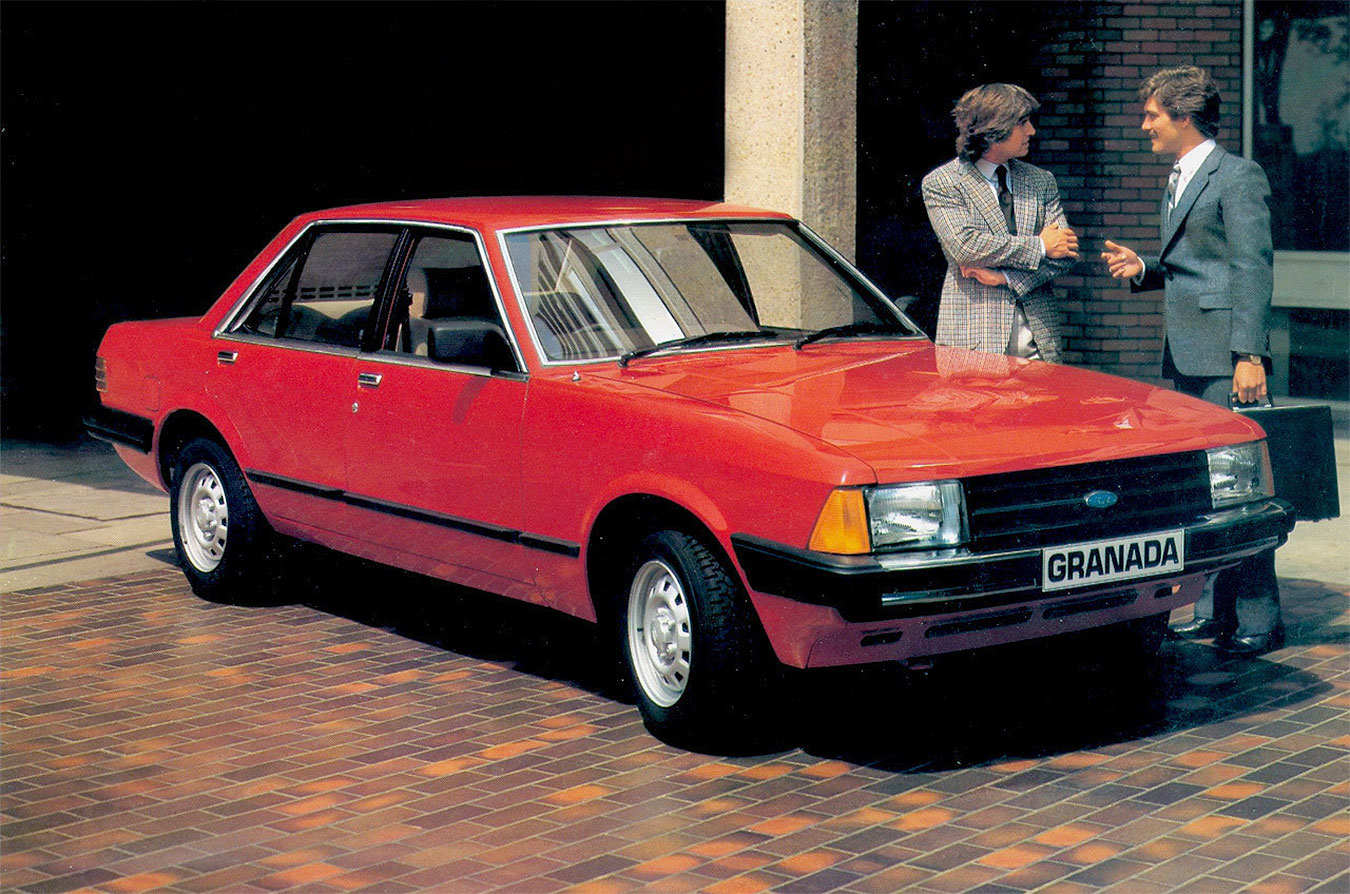
The Ford saloon is an endangered species.
Europe may be one of the saloon’s last bastions, but 2022 saw the death of the Ford Mondeo, with no replacement going on sale on the continent. It's part of a wider decline of the Ford saloon, once a bedrock of its range, offering the likes of the much-loved, and much-aspired to, Granada (pictured), as well as the Sierra and Cortina, the Mondeo's predecessors. With the recent demise of the Fiesta, and the Focus too soon enough, soon the only model that Ford sells in Europe that isn't an SUV will be the Mustang.
In America, Ford announced plans to eliminate saloons, estates, MPVs, and hatchbacks in 2018. Production of its last US market saloon, the Fusion, ended in August 2020 in Hermosillo, Mexico.
Ford’s decision represents a stunning about-face because its saloons regularly appeared on the list of its best-sellers for decades. Times change, markets evolve and the unthinkable sometimes becomes inevitable. Ford of Australia unknowingly blazed this path; it canned the rear-wheel-drive Falcon in 2016 and hasn’t looked back. Join us for a look at the rise and fall of the Ford saloon car, and some of its other related models and other shapes that aren't SUVs:
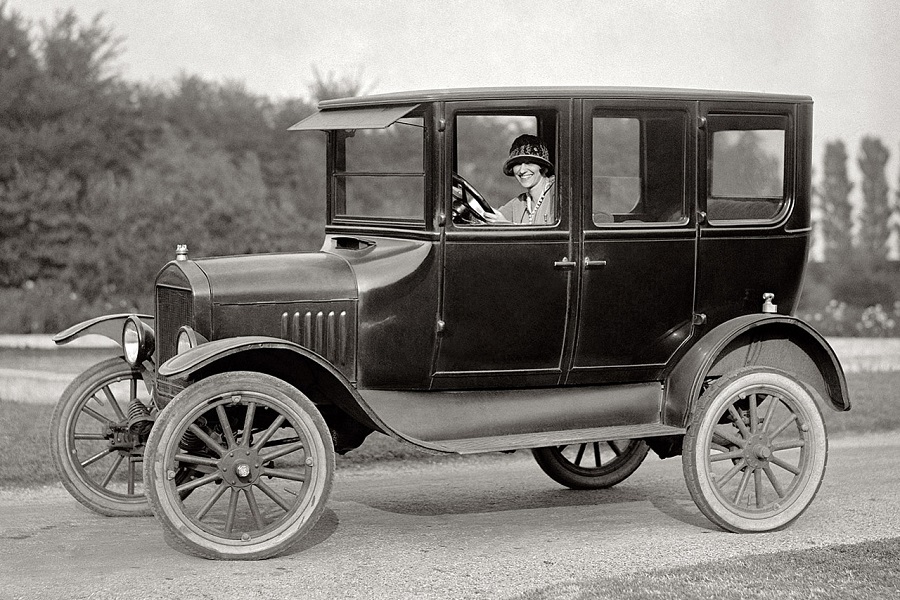
Model T (1908)
At launch, the Ford Model T was not a saloon in the traditional sense of the term. It was available with two rows of seats but the front compartment was often open and without doors. 1915 brought a closed body with two rows of seats and a centre-mounted door on each side. Ford shifted the T closer to the modern definition of a saloon when for 1923 when it launched a four-door model suitably called Fordor.
Ford made about 10,666 examples of the Model T in 1909 , a number that pales in comparison to the 15 million examples built during the car’s nearly 20-year long production run. Production began increasingly significantly in 1913 when Ford introduced the assembly line system. The system made the Model T more affordable, too. In 1922, annual Model T production totalled 1.3 million examples and Ford charged $319 (roughly $5000/£3600 in today's money) for an entry-level model.
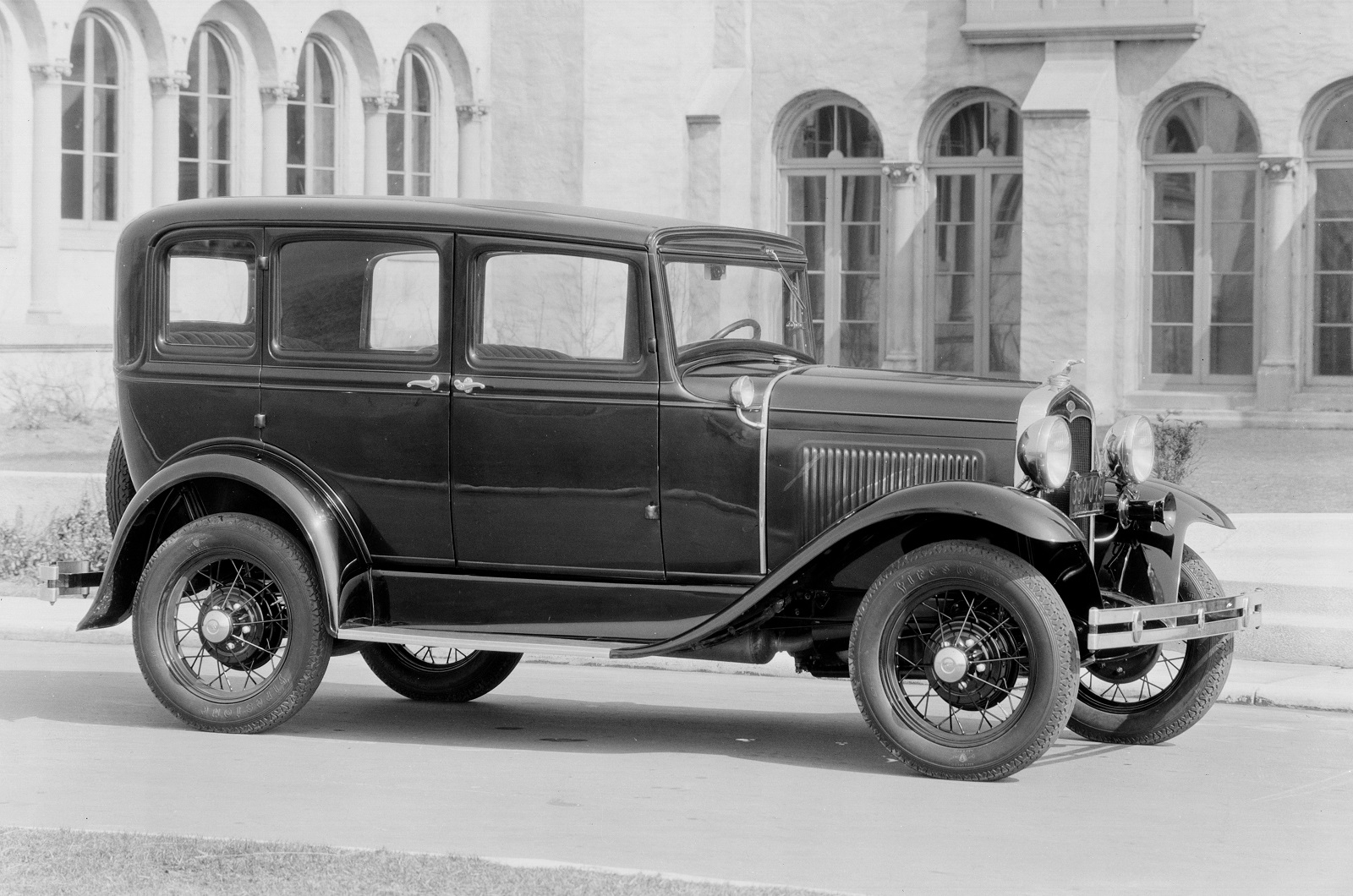
Model A (1928)
Introduced in December 1927, the Model A benefitted from the lessons that Ford learned during nearly two decades of Model T production. It was notably available as what can be accurately described as a four-door saloon right a launch, a move that signalled the body style’s growing popularity. Again called Fordor, it spawned a factory-built taxi model sold in limited numbers.
Ford charged $585 for the Fordor in 1928 (about $9000/£6500 today) and $600 (around $9200/£6600) for the taxi, which was the most expensive member of the range that year. Priced and sized right, the Model A enjoyed an immense amount of success. The millionth example was built in February 1929, a little over a year after series production started, and the two millionth unit was made in July 1929.

V8 (1932)
Ford democratised the V8 in 1932. Engines with eight or more cylinders weren’t rare in America (and even in Europe) at the time, but they powered cars that were out of reach for the average motorist. Developed secretly in a project led by Henry Ford himself, the 90-degree eight had a displacement of 3.6 litres and a 65bhp output.
It powered a new range of cars called Model 18 that included 14 body styles in 1932, its first year on the market. There were open- and closed-top cars as well as two- and four-door variants. 57,930 units of a two-door saloon named Tudor (pictured as a 1934 model) were sold in 1932, a figure that made it the most popular body style by a wide margin. Ford also offered a more expensive Deluxe model and a four-door saloon called Fordor.
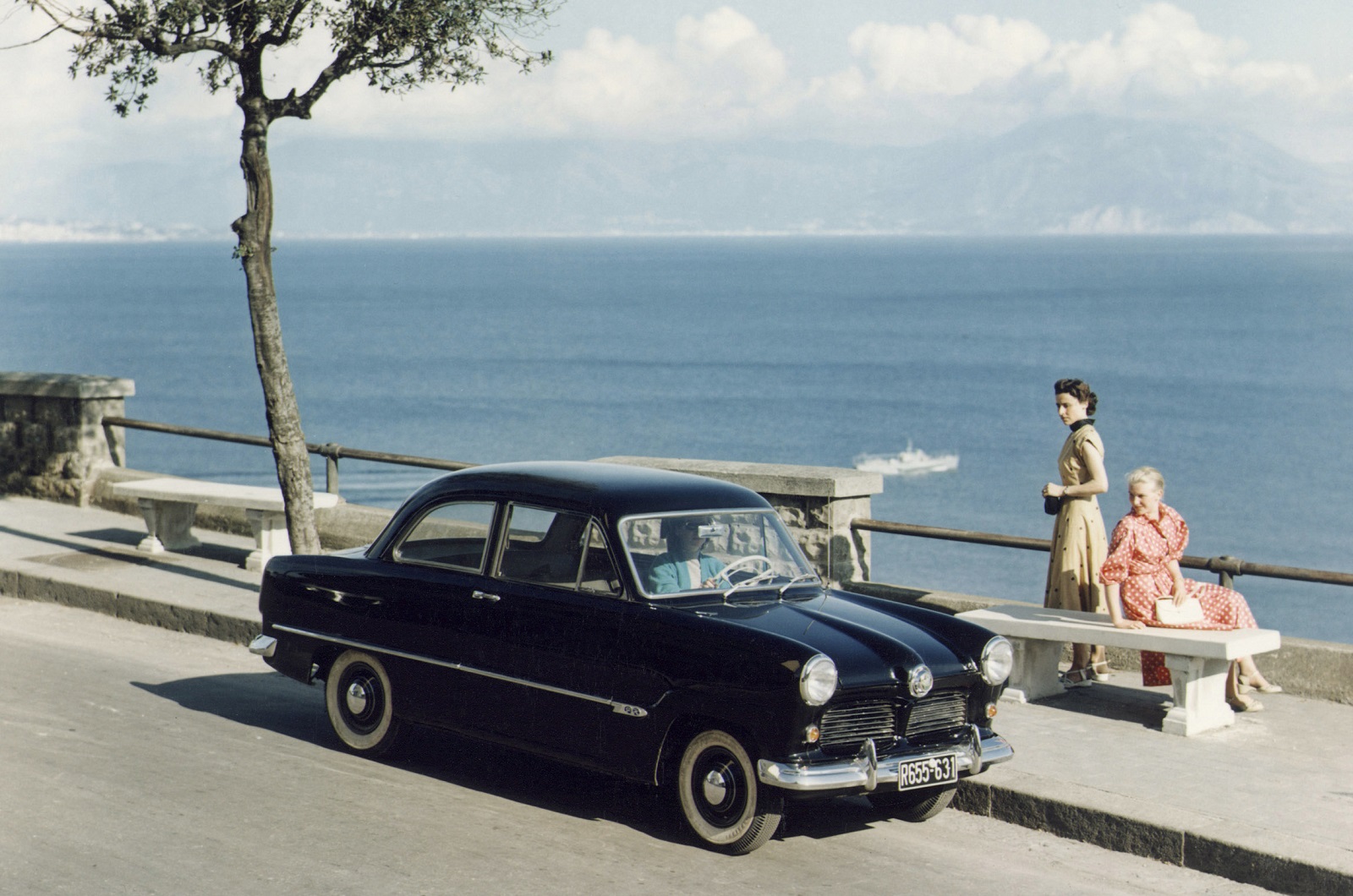
Taunus (1939)
Ford used the Taunus nameplate on over a dozen cars starting in 1939. Saloons were a core part of this range; two- and four-door Taunus models represented Ford in Germany and in a number of Scandinavian nations. The need to achieve economies of scale gradually brought the Taunus and the Cortina closer in the 1970s. Both were replaced by the Sierra, though production continued in some overseas markets. PICTURE: 12M model.
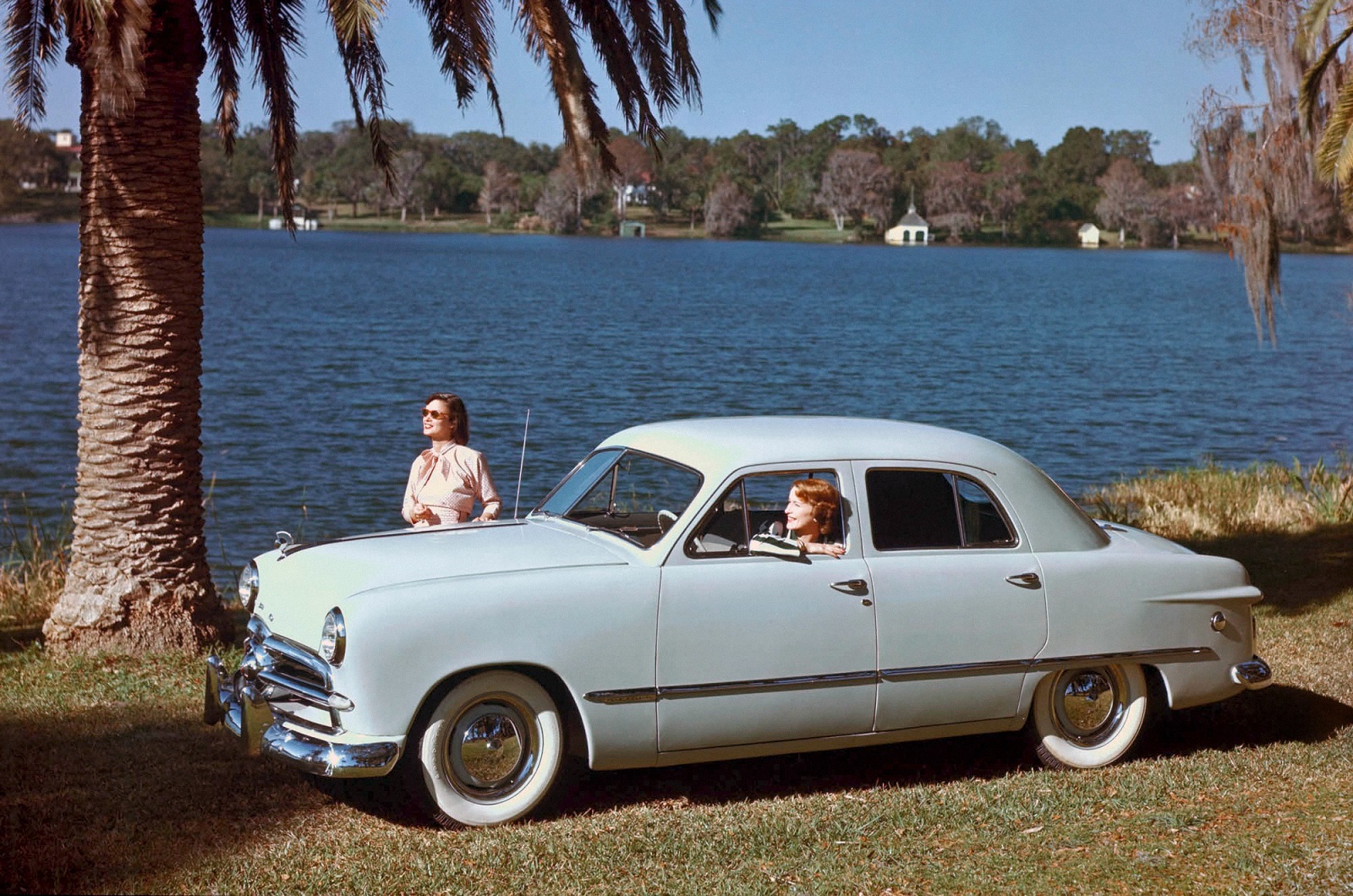
1949 models
Ford resumed production of some of its pre-war models after the Second World War but sales were relatively low because motorists were looking for something new. After cancelling two projects due out in 1948, Ford returned to the drawing board and developed its 1949 range in about 18 months, a feat many scoffed couldn’t be accomplished. Elegant and modern, the 1949 range was a hit; Ford received 100,000 orders for the new car on the first day it began selling it. Split into two basic lines called Standard and Custom, the range included two- and four-door saloons, a six-seater coupe, an estate and a convertible.
In hindsight, the 1949 models saved Ford. It built 1,118,740 cars in 1949, a big increase over 1948 and about 100,000 more than Chevrolet. Historians estimate the 1949 range earned Ford a much-needed $177 million profit (approximately $1.9 billion/£1.4 billion today) during its production run.
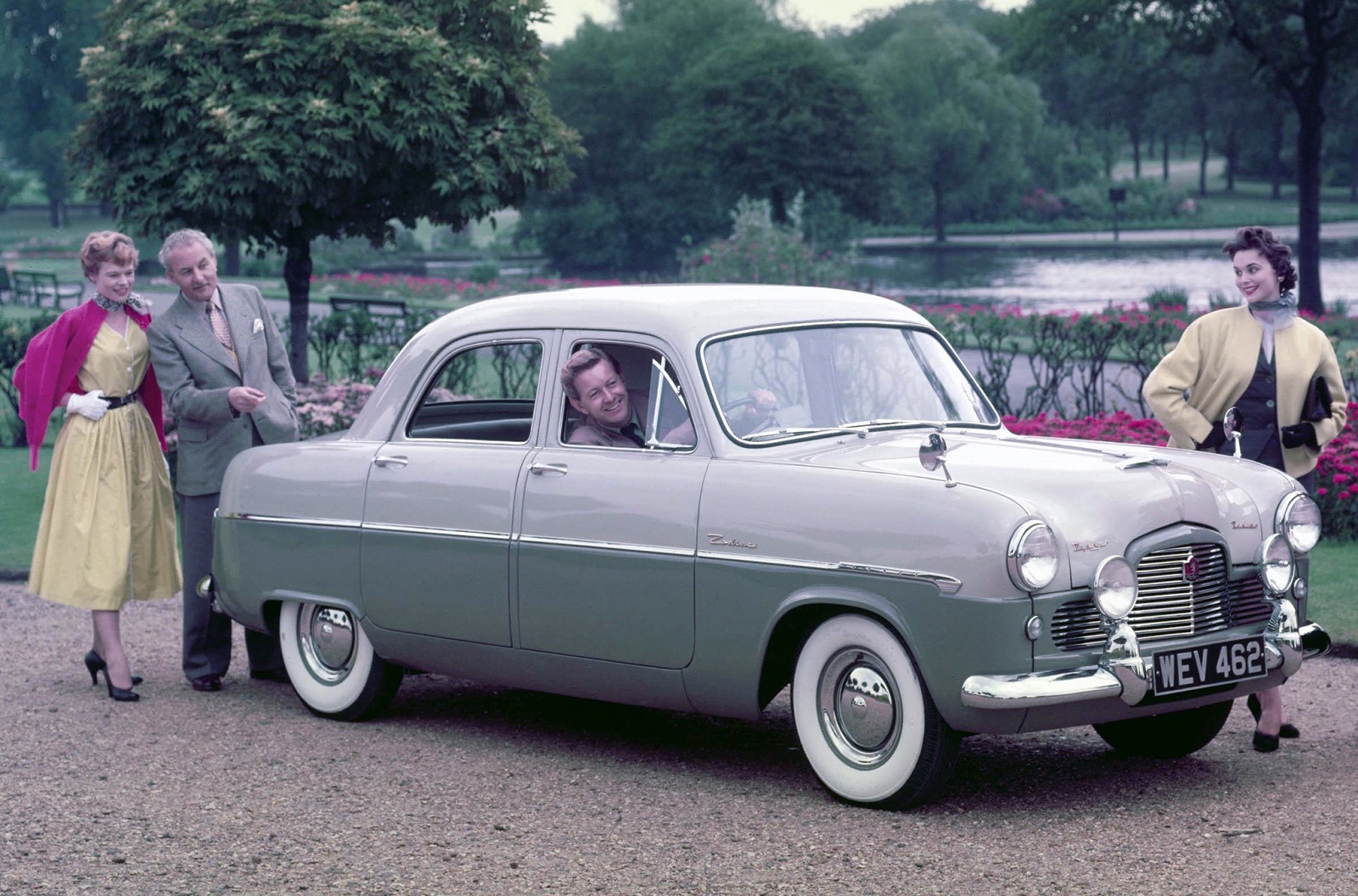
The British connection (1940s)
British-made Ford models, like the Anglia and the Prefect, began trickling into America after World War II. While none were as popular as American-designed cars, they amassed a following because they were small, robust cars from a trusted name. Around 3223 units were sold in 1948. Ford released the Consul in 1951, and it launched the six-cylinder-powered Zephyr (pictured) the following year.
Sales increased to 33,472 units in 1958, which represented approximately 11% of the cars built by Ford of Britain that year. Demand for saloons was high enough for Ford to justify selling two distinctly different line-ups. Ford sent about 10,200 British-built cars to America in 1970. Sales ended before the 1971 model year.

Falcon (1960)
Ford’s answer to the Chevrolet Corvair was the Falcon, a compact model launched for the 1960 model year. Buyers could choose between two- and four-door saloons and two- and four-door estates. Every body style was available only with a straight-six engine, though the Falcon’s mechanical layout was far more conventional than the Corvair’s. 435,676 units were sold during the 1960 model year, a figure that illustrated a growing demand for smaller, more efficient cars across the US. Not much celebrated today, the Falcon would nonetheless provide a platform for a legendary car, as we'll see shortly...
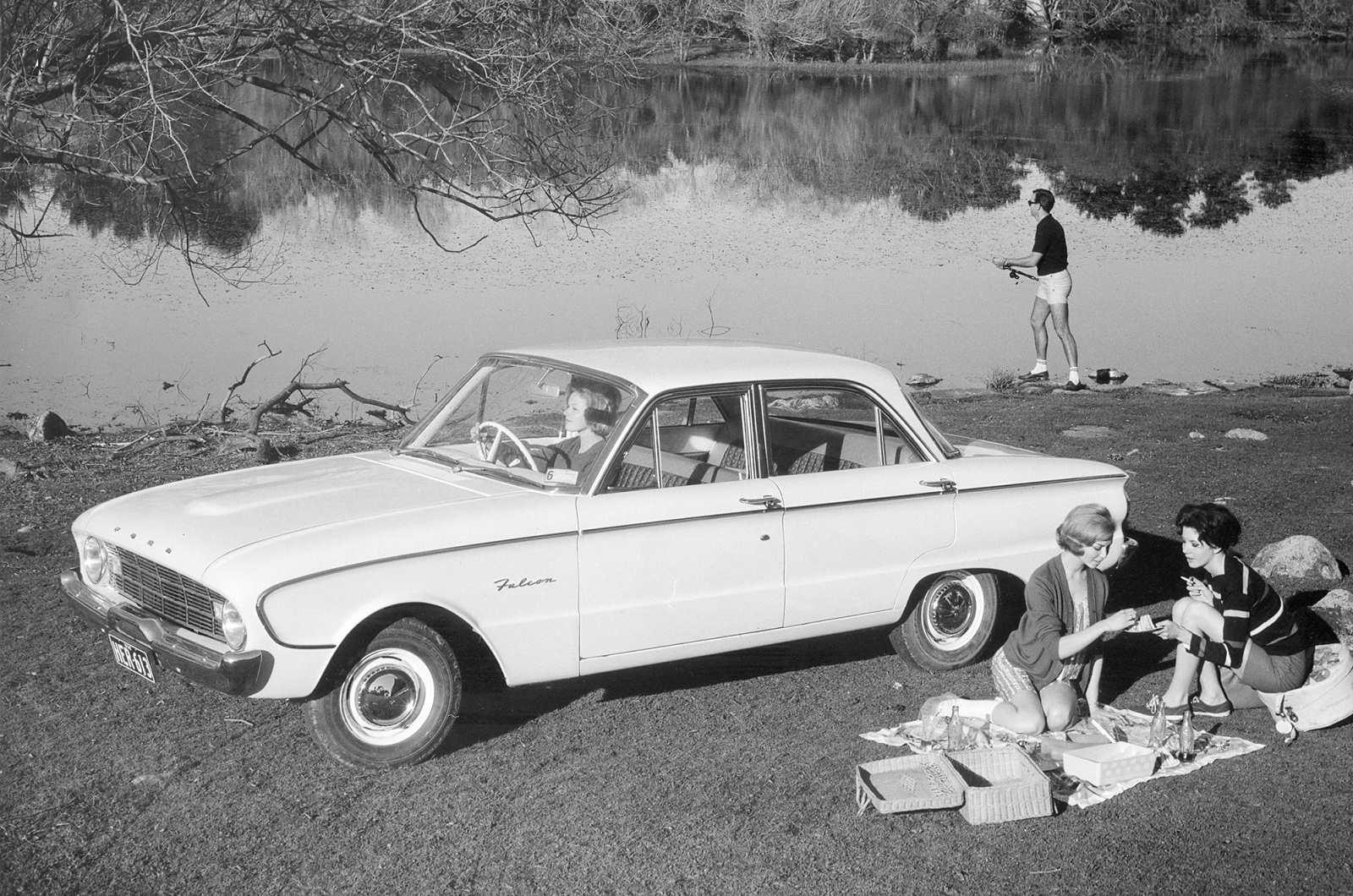
Falcon (1960, Australia)
Ford brought the Falcon to Australia in 1960 to lure buyers out of Holden showrooms. Initially, Australia’s Falcon was closely related to the American model but it received market-specific tweaks, like a heavy-duty suspension system and, of course, right-hand-drive. It was far more popular than Ford of Australia’s earlier saloons, which mostly traced their roots to the UK, so the range grew in the 1960s.
It took only a few years for the Falcon to become a common sight on Australian roads and race tracks. Later variants of the Australian-built Falcon were developed locally, and the nameplate survived much longer than it did in the United States. Seven generations were built over the course of 56 years.
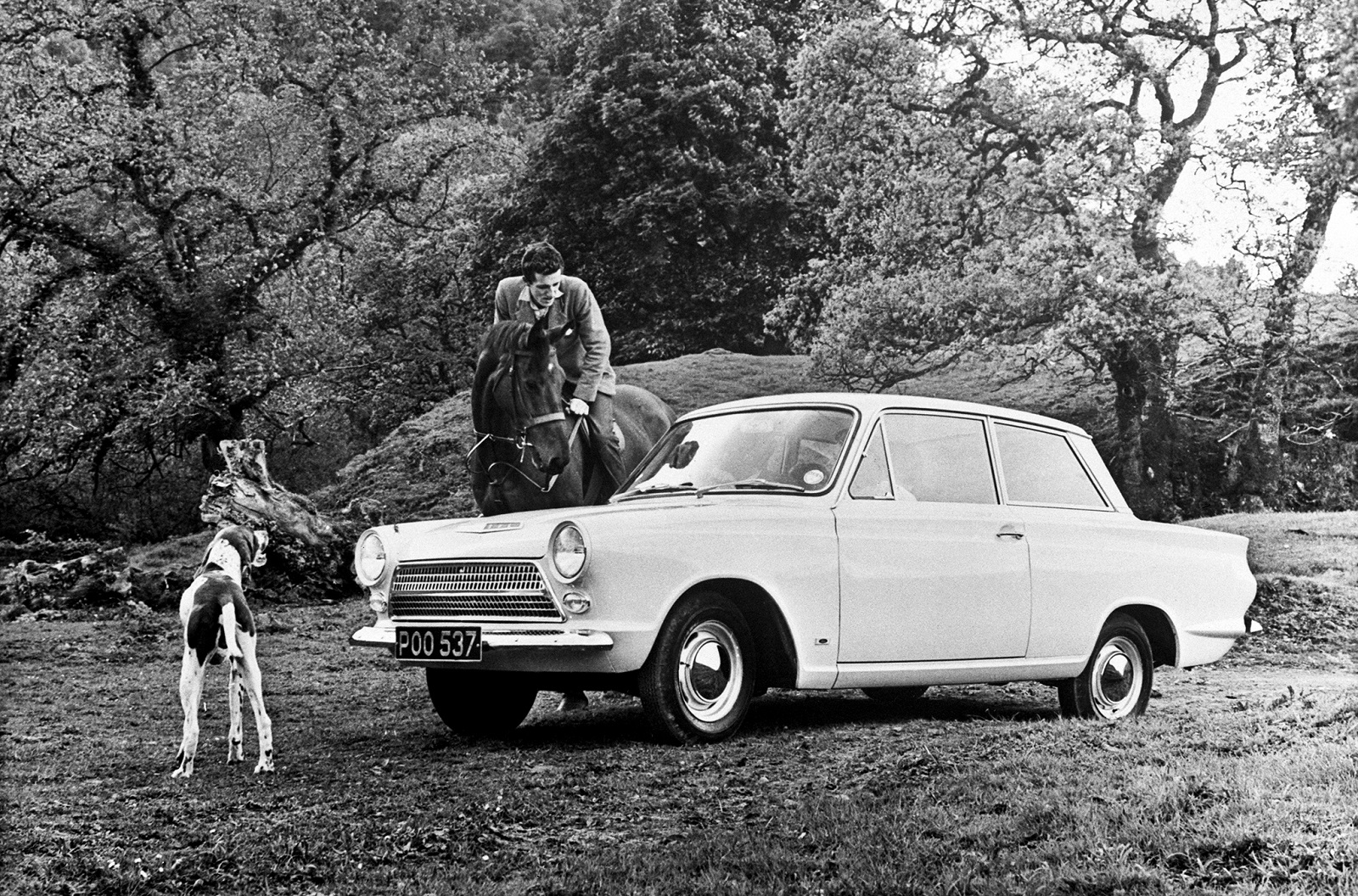
Cortina (1962)
Developed in the UK, the Cortina was the right car at the right time. It was released in 1962 with a spacious interior, an elegant design, and a variety of available four-cylinder engines. While enthusiasts primarily remember the Lotus-tuned model, the run-of-the-mill saloon and estate variants were even more important because they were permanent fixtures on the United Kingdom’s best-sellers chart.
116,637 units of the Cortina were sold in 1965, placing it in second place behind the Austin/Morris 1100. It notably finished ahead of the Mini by about 12,000 sales, and far ahead of the smaller Anglia. For context, the best-selling car in the United Kingdom in 2019 (2020’s numbers were skewed by the pandemic) was the Fiesta, with 77,833 units. The Mondeo wasn’t in the top 10.

Mustang (1964)
Unveiled in New York City, the Falcon-based Ford Mustang became an instant hit; it was the must-have car of the year. Derived from the Falcon, Ford received 22,000 orders within 24 hours of the car’s introduction, which was nearly a quarter of the 100,000 cars it hoped to sell annually. Over 418,000 units had found a home by its first birthday, a number that would have made it one of the five best-selling vehicles in America today.
Today, the Mustang remains Ford’s affordable dream car and by some measures is the world's best-selling sports car. An all-new seventh generation model was unveiled in September 2022.

Escort (first generation for Europe, 1967)
Ford first used the Escort nameplate in 1955 on an estate variant of the Anglia 100E, but the designation didn’t denote a standalone model until 1967. Launched to replace the Anglia, the first-generation Escort was a hugely significant car because it was developed by Ford of Europe, rather than by its British or its German division. It was built in both countries with minor market-specific differences starting in 1968.
The original Escort range covered a stunningly broad spectrum, from wallet-friendly economy-oriented models to high-performance rally-bred variants, and it quickly became one of the best-selling cars in the UK. Ford sold 103,817 units in 1975, putting the model in second place behind the Cortina (106,787 sales). Most of the subsequent generations enjoyed a similarly high level of popularity; the Escort was the UK’s best-seller in 1985 (157,269 units) and again in 1995 (137,760 sales). Production for the European market ended in 2002, when the Escort finally passed the torch to the first-generation Focus released four years earlier.
Ford resurrected the Escort nameplate on the Chinese market in 2015. Not sold outside of its home country, the made-in-China Escort is somewhat ironically based on the second-generation Focus.

Pinto (1971)
Ford named its entry into the burgeoning sub-compact segment Pinto. Released for the 1971 model year, it was positioned at the very bottom of the company’s line-up and initially offered only as a two-door sedan. Europe played a significant role in the Pinto’s launch: Engine options consisted of a British-built 1.6-litre and a German-built 2.0-litre. Selling four-cylinder engines to drivers hooked on V8s proved easier than many assumed and about 352,000 units of the Pinto were manufactured in 1971.
1972 brought a two-door estate and the future looked relatively bright. However, the Pinto’s career was marred by the rear-mounted fuel tank which was prone to leaking and causing an explosion if the car was hit from the back. Ford ended up recalling 1.5 million examples of the Pinto in 1978.
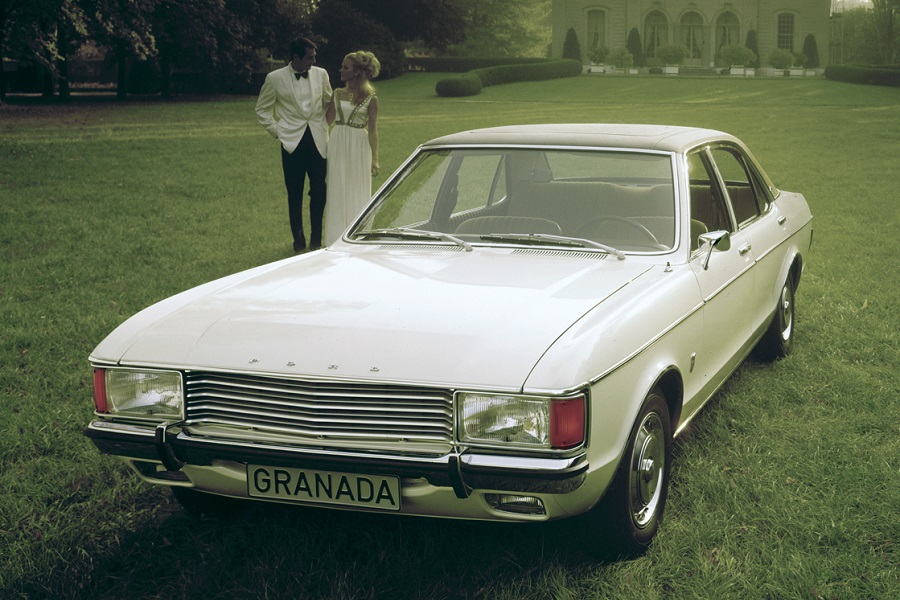
Granada (1972)
Released in 1972, the first-generation Granada symbolically represented the integration of Ford’s British and German divisions. It replaced the Zephyr, which came from the UK, and the P7, which was developed in Germany. Factories in both countries built the Granada with either a V4 or a V6 engine.
1977 brought the second-generation Granada, which was offered as a two- or a four-door saloon and as an estate. While it was not as popular as Ford’s smaller models, it regularly stood proud as the best-selling model in its class, especially in the UK. Ford retired the nameplate in continental Europe in 1985, but it brought it back for the third and final time on the British variant of the Scorpio.
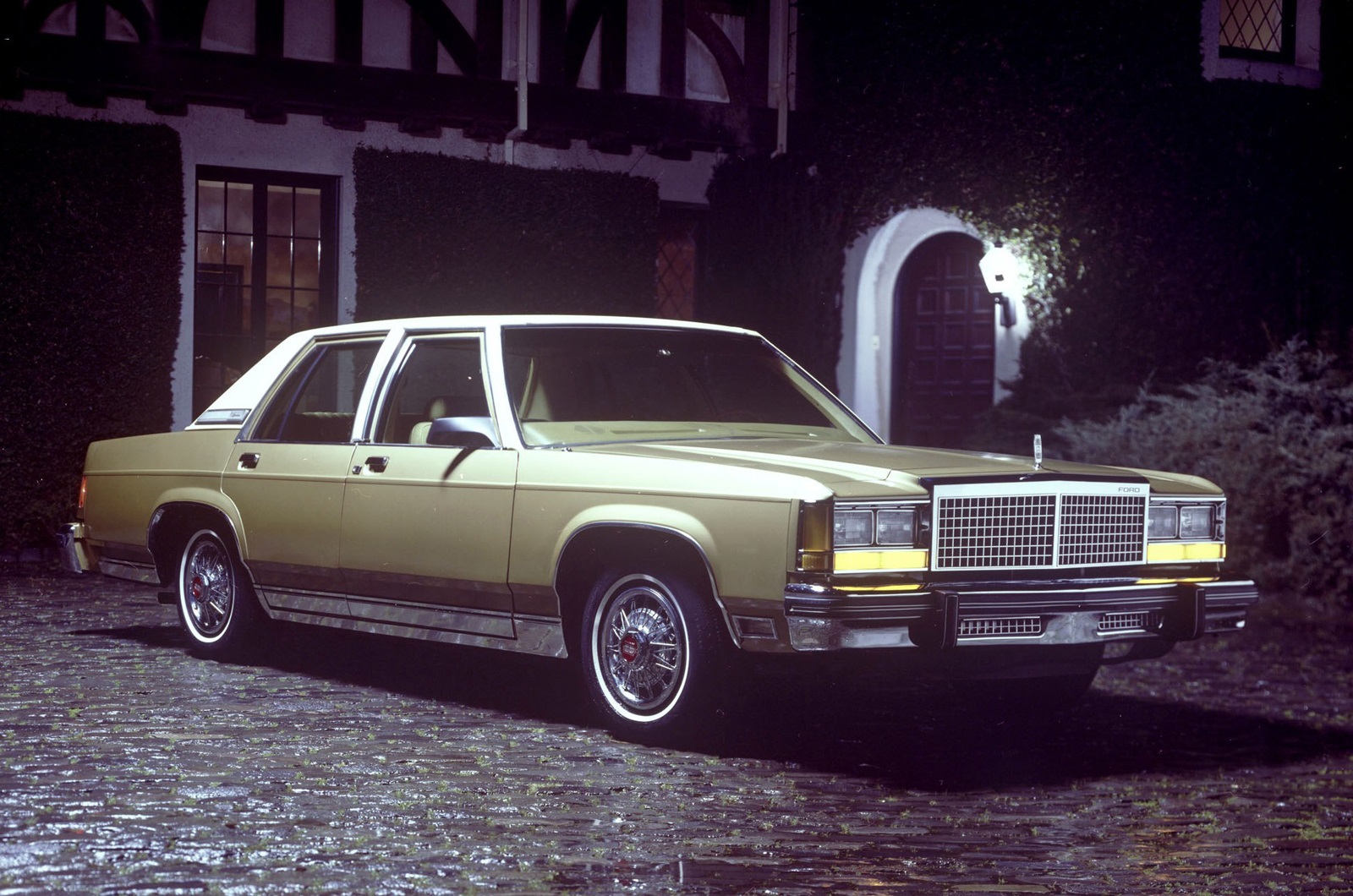
LTD (third generation, 1979)
Strict fuel economy regulations took their toll on Ford sales during the 1970s and the solution was downsizing. Launched for the 1979 model year, the third-generation LTD was tested in a wind tunnel for 270 hours to ensure its design was as aerodynamic as possible.
Its wheelbase was about seven inches shorter than its predecessors and it consequently weighed much less; Ford pegged the estate’s weight at 1672kg (3678 lb), versus 2060kg (4532 lb) for the 1978 model. It carried on with body-on-frame construction, however, and it inaugurated the first generation of the long-running Panther platform.

Sierra (1982)
Like the Granada, the Sierra was a one-size-fits-all solution to replacing overlapping models made by Ford’s British and German divisions. It stood out from the Taunus and the Cortina, its predecessors, with an aerodynamic design that left no one indifferent. Some loved it, and others hated it; few ignored it.
Ford built the Sierra for over a decade in more than half a dozen countries. The range included two- and four-door liftbacks, a four-door saloon, an estate, and even a pickup called P100. Rear- and four-wheel-drive variants were offered, and a range-topping model tuned by Cosworth arrived in 1988. In hindsight, the Sierra managed to represent all facets of Ford during the 1980s, and helped the company to dominate the UK car market, where its market share hovered consistently around the 30% mark.
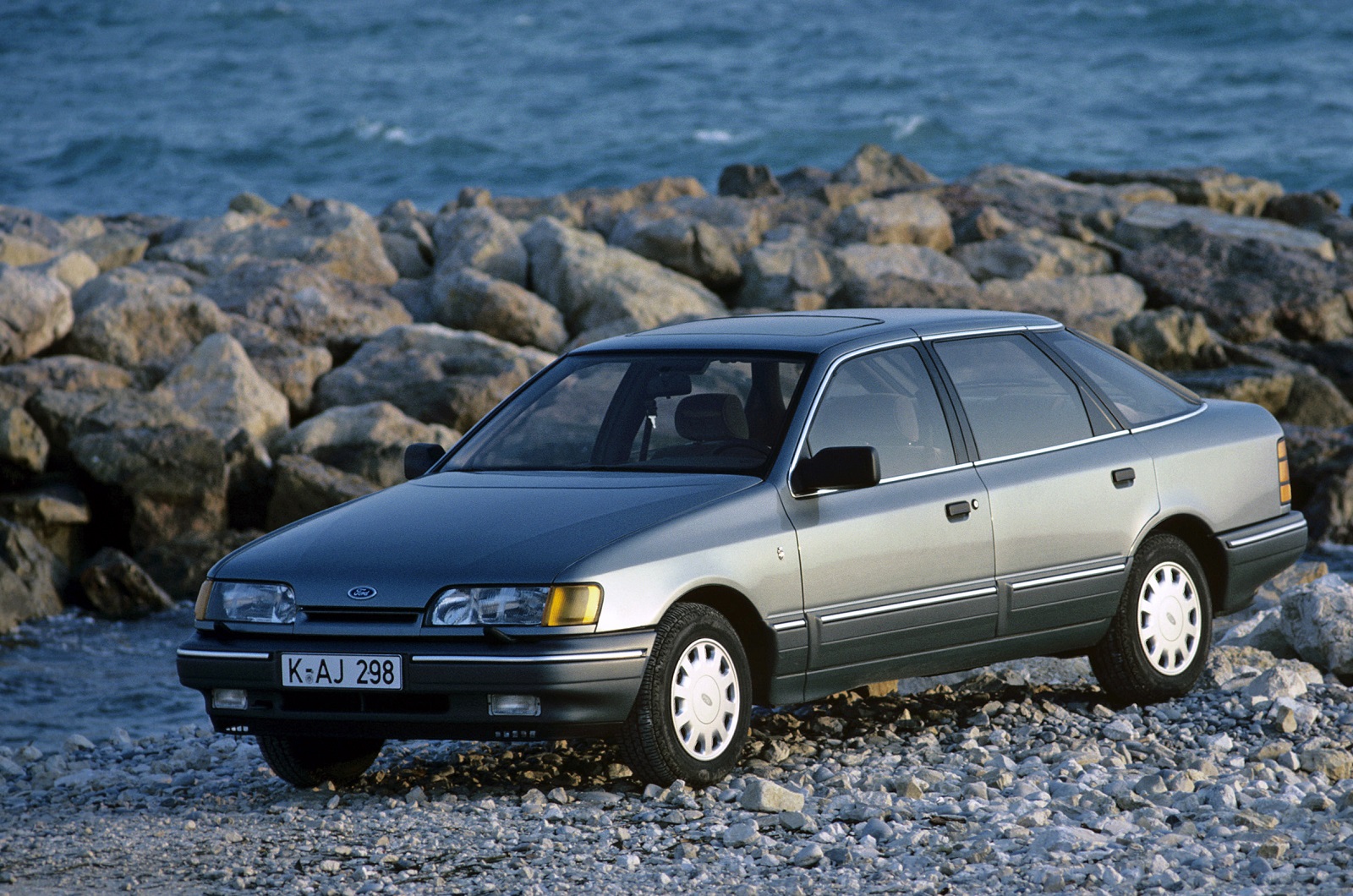
Scorpio (1985)
Sold as the Granada in the UK and Ireland, the Scorpio made its debut in 1985 as a bigger evolution of the Sierra. It was initially offered only as a four-door hatchback, but the class it competed in was big enough for Ford to launch a four-door saloon and a four-door estate later in the model’s life cycle.
All three offered a relatively high level of equipment, including ABS brakes, plus a level of comfort and refinement normally associated with more expensive cars. Production of the first-generation Scorpio ended in 1994, and the second-generation model (which ditched the Granada name) arrived that same year. It was the first car that Ford designed drawn with software, and it showed. It was also the last big saloon the company sold in Europe. Sales ended in 1998, and the second Scorpio retired without a direct successor.
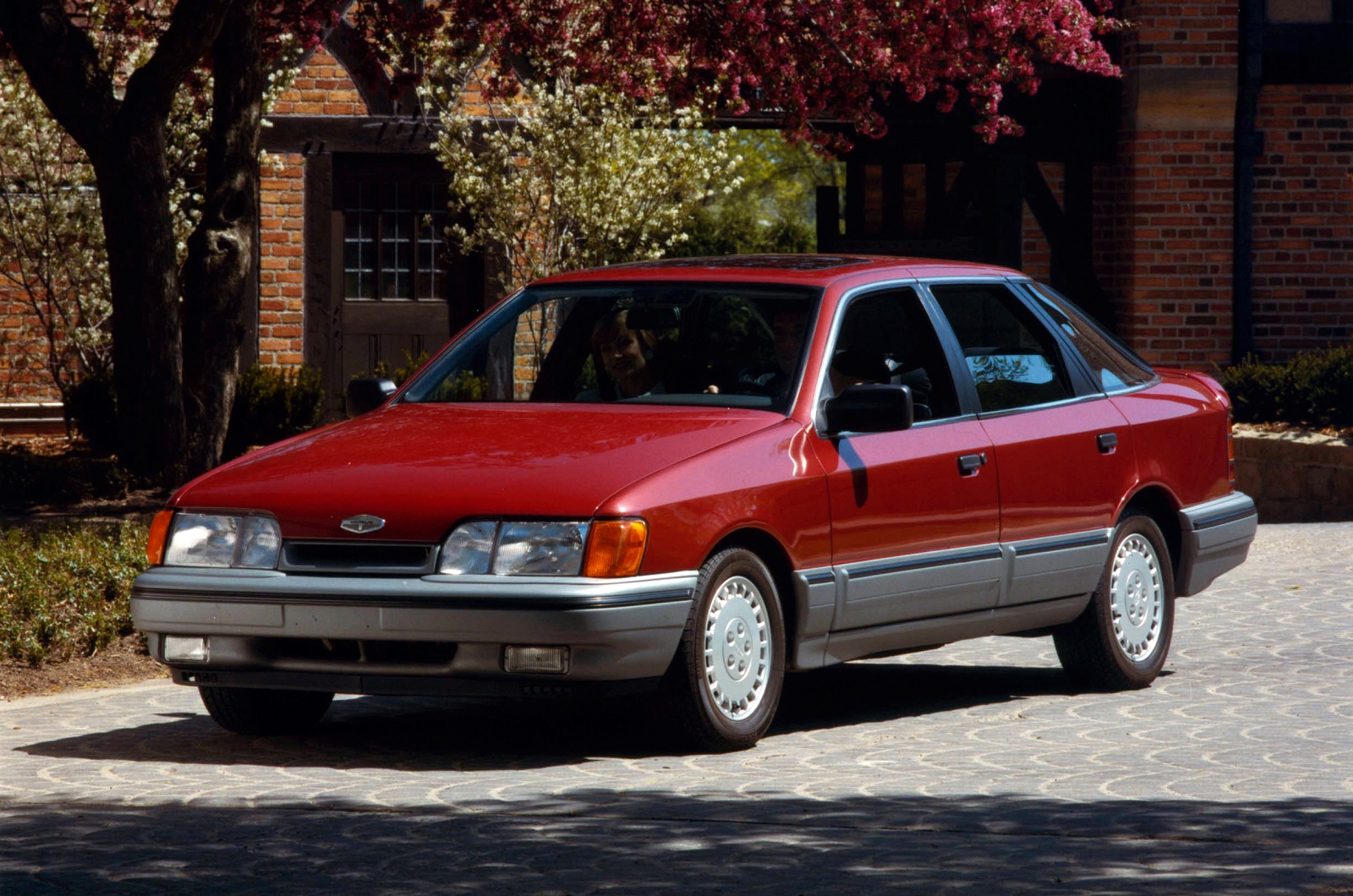
The German connection (1985)
Ford took a shot at its European rivals by creating the Merkur brand. Launched for 1985, the line-up initially consisted only of the two-door XRT4i, which was built in Germany and closely related to the Sierra XR4Ti sold in Europe. 1988 brought the Scorpio, a four-door saloon wearing a nameplate Europeans were familiar with. Merkur sales peaked at 15,261 units in 1988 but dropped to 8,765 the following year and 2,622 in 1990. Short-lived, the Merkur brand was axed after 1990.
It was an experiment that Ford never tried again.
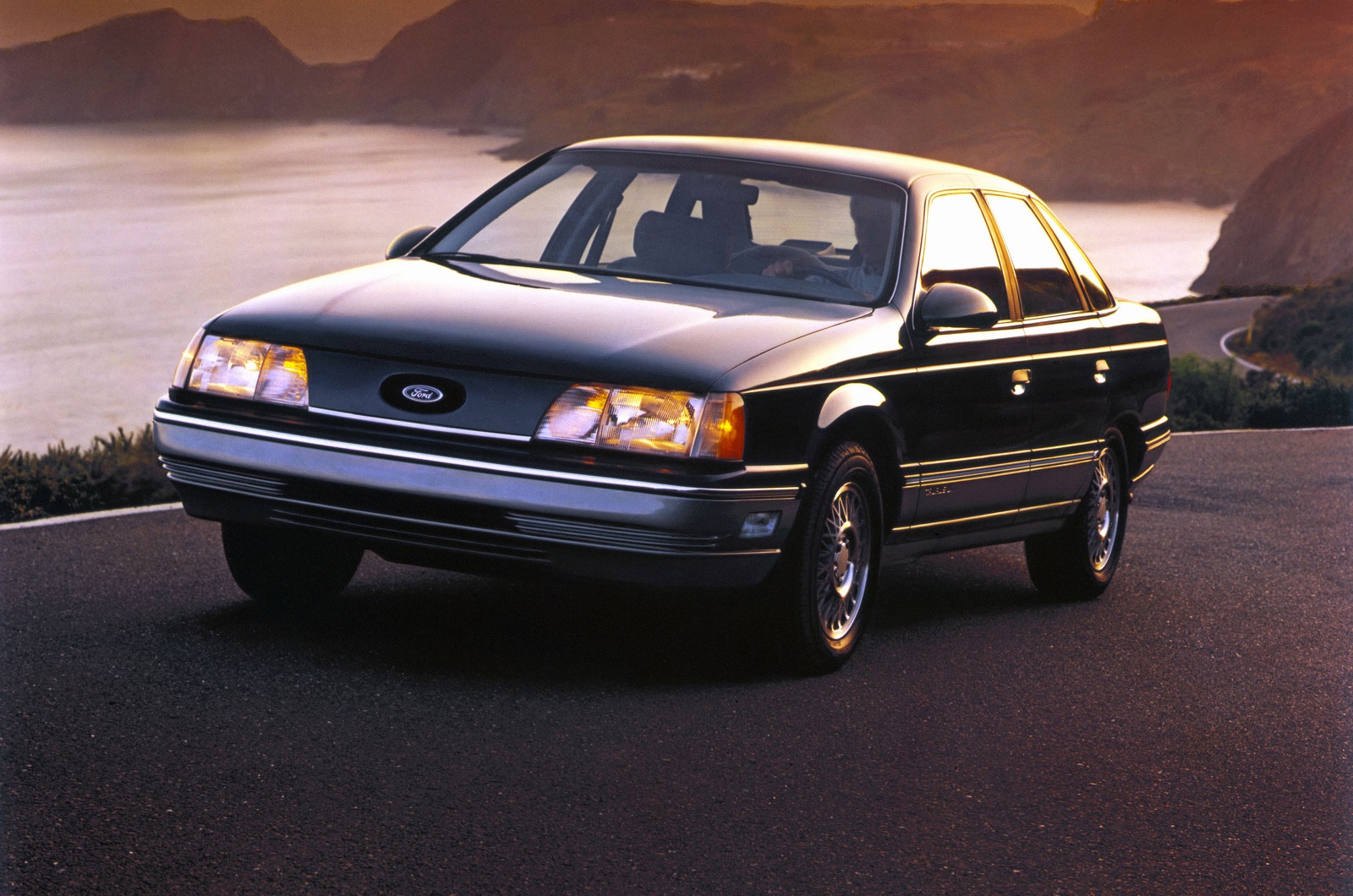
Taurus (1986)
Going global paid off when developing the Escort, but Ford knew it couldn’t apply the same recipe to the mid-size, front-wheel-drive model it planned to release for 1986. Japanese rivals were encroaching on its territory, and there was too much at stake not to develop the car with the American market in mind.
Launched to replace the LTD, the Taurus arrived with an aerodynamic design and either a four- or a six-cylinder engine. Ford paid particular attention to the model’s build quality to avoid costly recalls that hurt its sales and its reputation. At launch, the Taurus was praised as one of Ford’s all-time greatest hits.
Ford sold 178,737 Taurus saloons and 57,625 estates in 1986. Those figures increased to 294,576 and 93,001, respectively, in 1988. Escort sales (including the EXP) totalled 422,035 units that year.
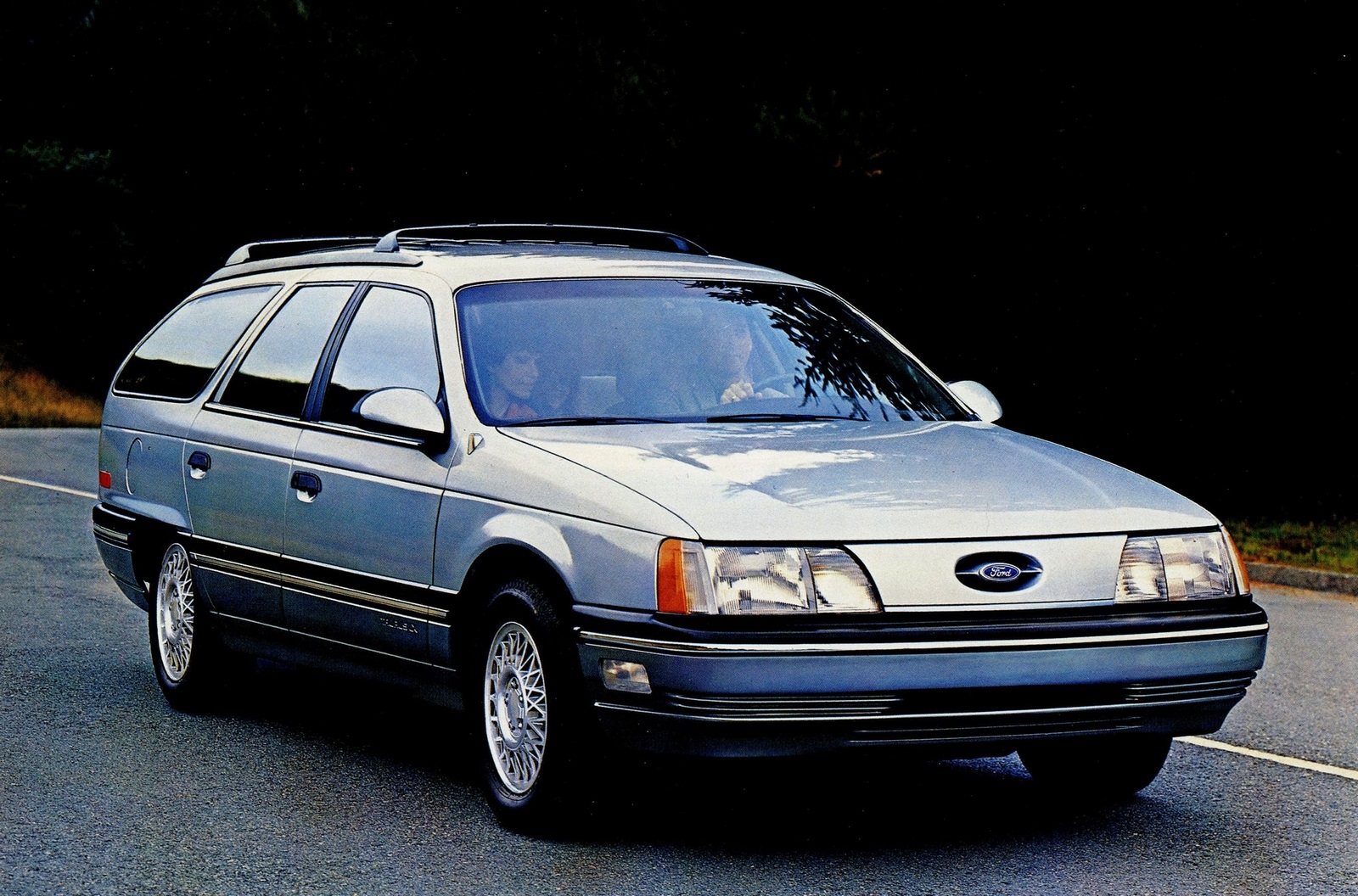
Ending the decade on a high note (1980s)
Ford’s fortunes looked boundless in the late 1980s. It raked in $53 billion in net revenue in 1988 (more than General Motors) and it sold 1,535,145 cars and trucks during the model year (slightly more than rival Chevrolet). America’s best-selling car that year was the Escort (381,330 units), followed by the Taurus (367,327 units). Honda’s Accord finished third with 362,118 sales. Ford also ruled the truck chart: 588,452 examples of the F-Series found a home.
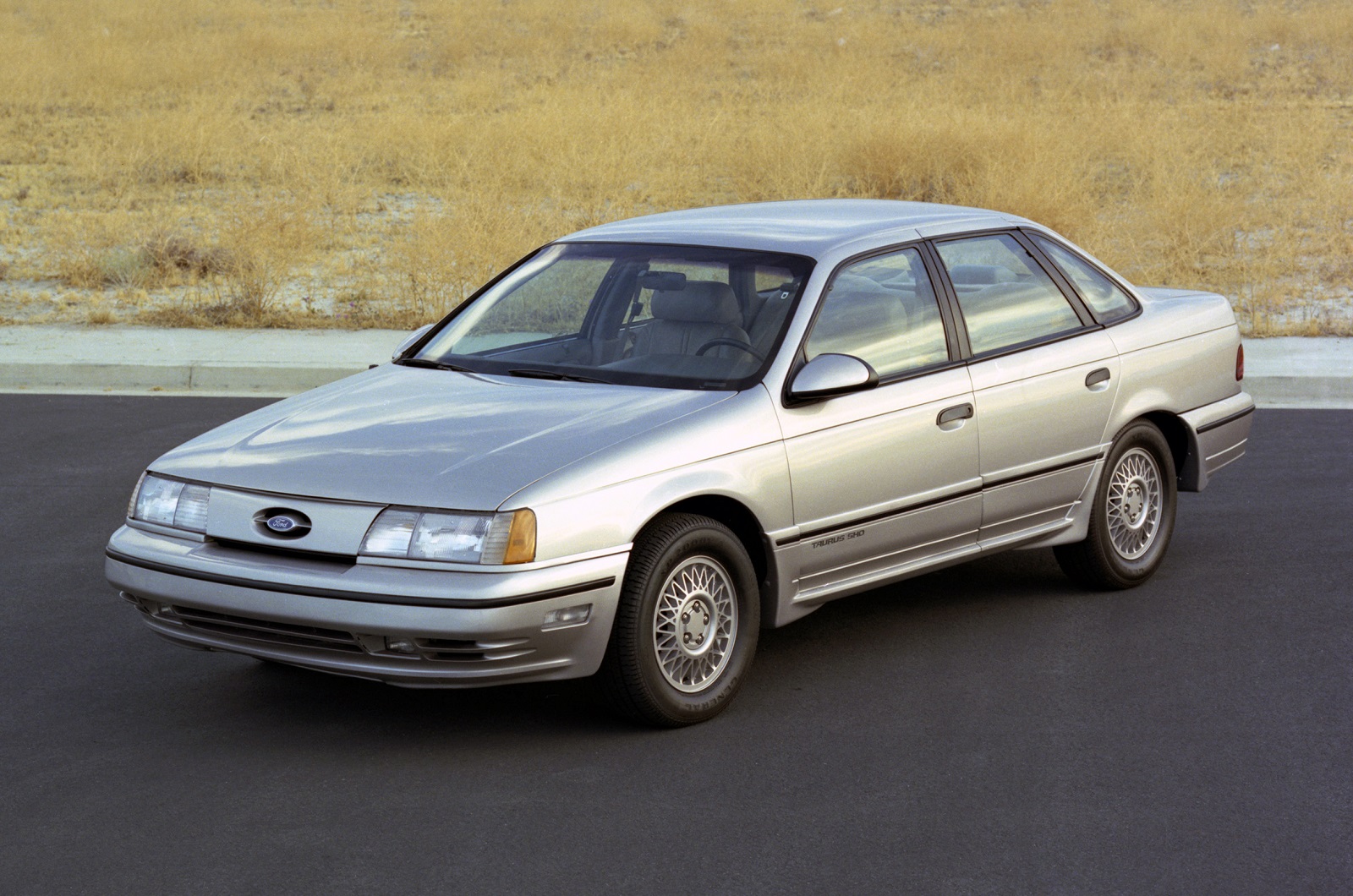
Taurus SHO (1989)
Flush with cash, Ford started spreading performance across its range. It released the hot-rodded Taurus SHO for the 1989 model year with a 217bhp, 3.0-litre V6 engine built by Yamaha and a five-speed manual transmission. Better brakes and suspension improvements complemented the extra power, and a subtle body kit plus model-specific alloy wheels allowed car-spotters to identify the SHO.
Like the standard Taurus, the SHO was exceptionally well received by the public and the press. 15,504 units were sold in 1989 despite a base price pegged at $19,739 (about $41,700/£30,100 today).
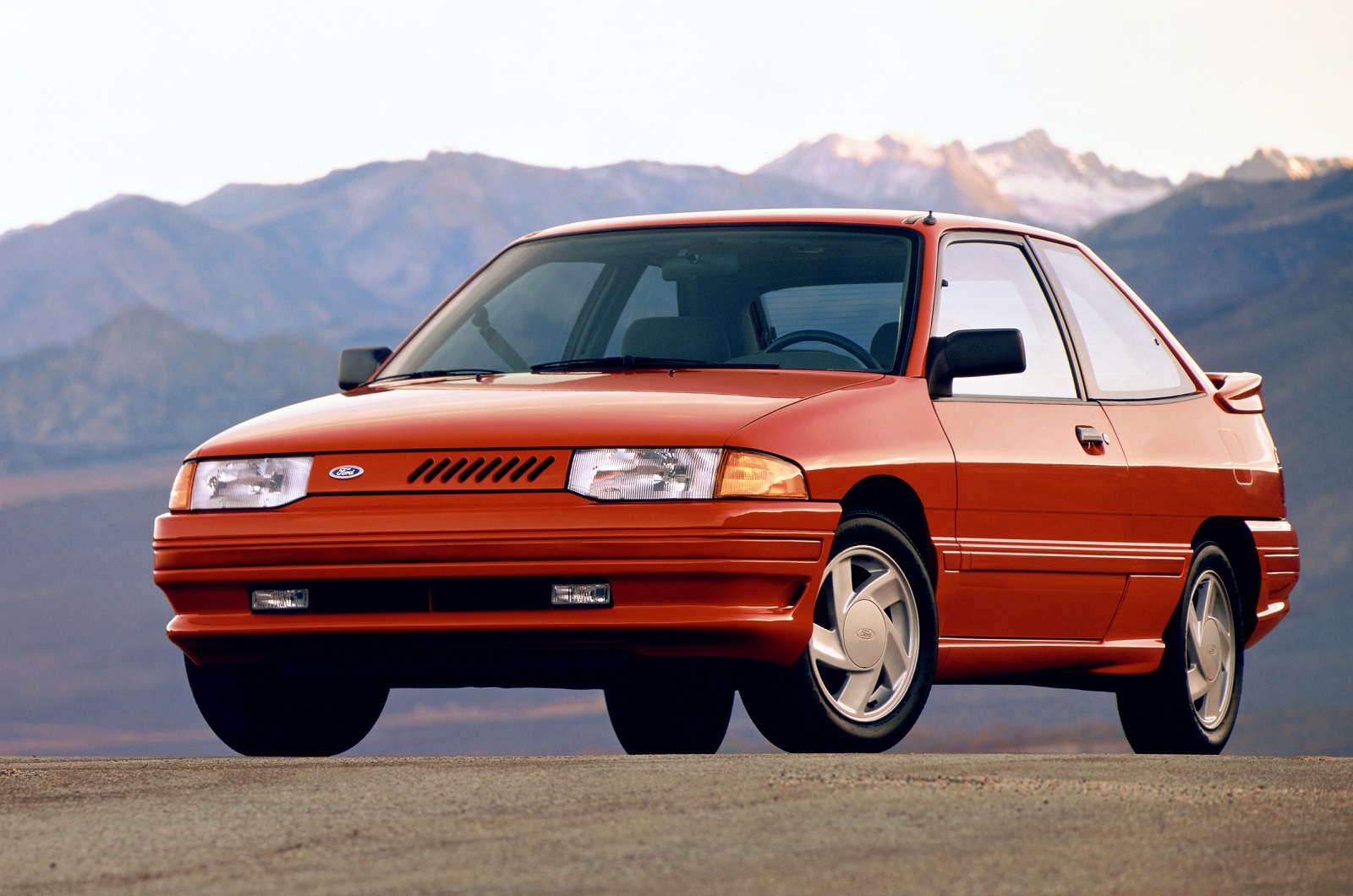
Escort (second generation for America, 1991)
Ford’s big-ticket model during the 1990s was the Explorer, which played a significant role in popularising SUVs on off-road trails and mall parking lots across America, but cars remained a significant part of its range. Its attitude towards the segment had started to shift, however. Instead of selling Europe’s variant of the Escort in America, it asked Mazda (which it owned a 25% stake in) to help it develop a new car specifically for the United States. Launched for 1991, the range included a coupe, a saloon, and an estate. All three wore a modern-looking design that borrowed some styling cues from the Taurus.
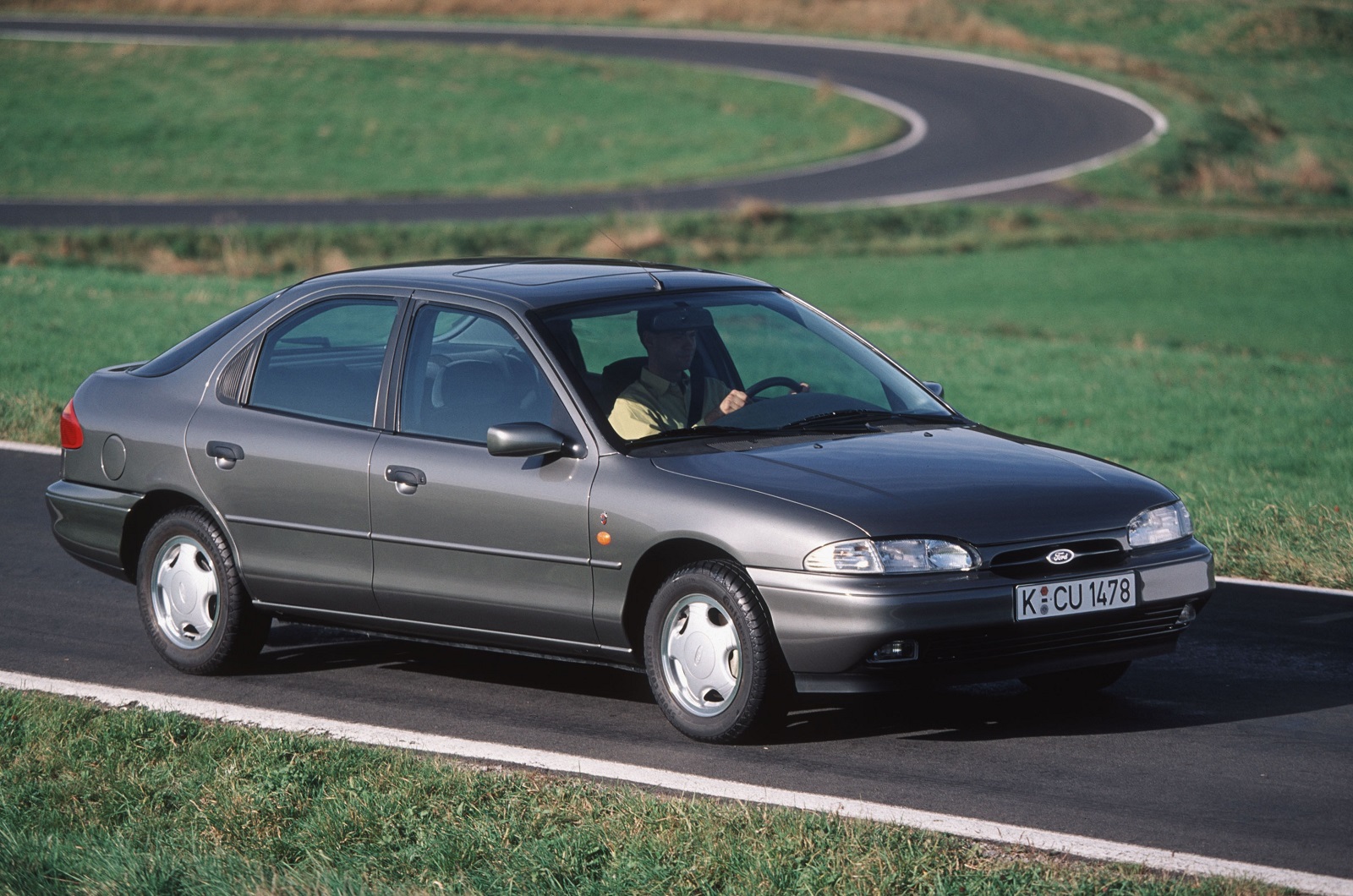
Mondeo (1992)
Introduced in 1992, and celebrated as a world car, the first-generation Mondeo played a significant role in propelling Ford of Europe to stardom during the 1990s. In the UK, it helped Ford outsell Vauxhall, its arch rival. It later became the Contour in America, and it spawned the Mercury Mystique. 118,040 units of the Mondeo were sold in the UK in 1995, a figure that placed it in third place behind the Escort and the Fiesta, and comfortably ahead of the Vauxhall Cavalier (73,978 sales). It was a company car, a family car, and a sports car when Ford added V6-powered ST-branded models to the line-up in the late 1990s.
Demand for the Mondeo gradually dropped during the 2000s; sales totalled 57,589 units in 2005. It lost its world car vocation when Ford chose not to replace the Contour, but the Mondeo returned to the United States as the Fusion in 2012. Designing one saloon for two markets made sense, because sales were too low in each to justify making a country-specific car. By 2017, the Mondeo had fallen off the UK’s top-10 list, and the Fusion lingered in 19th spot with 209,623 sales, far behind its main rivals.
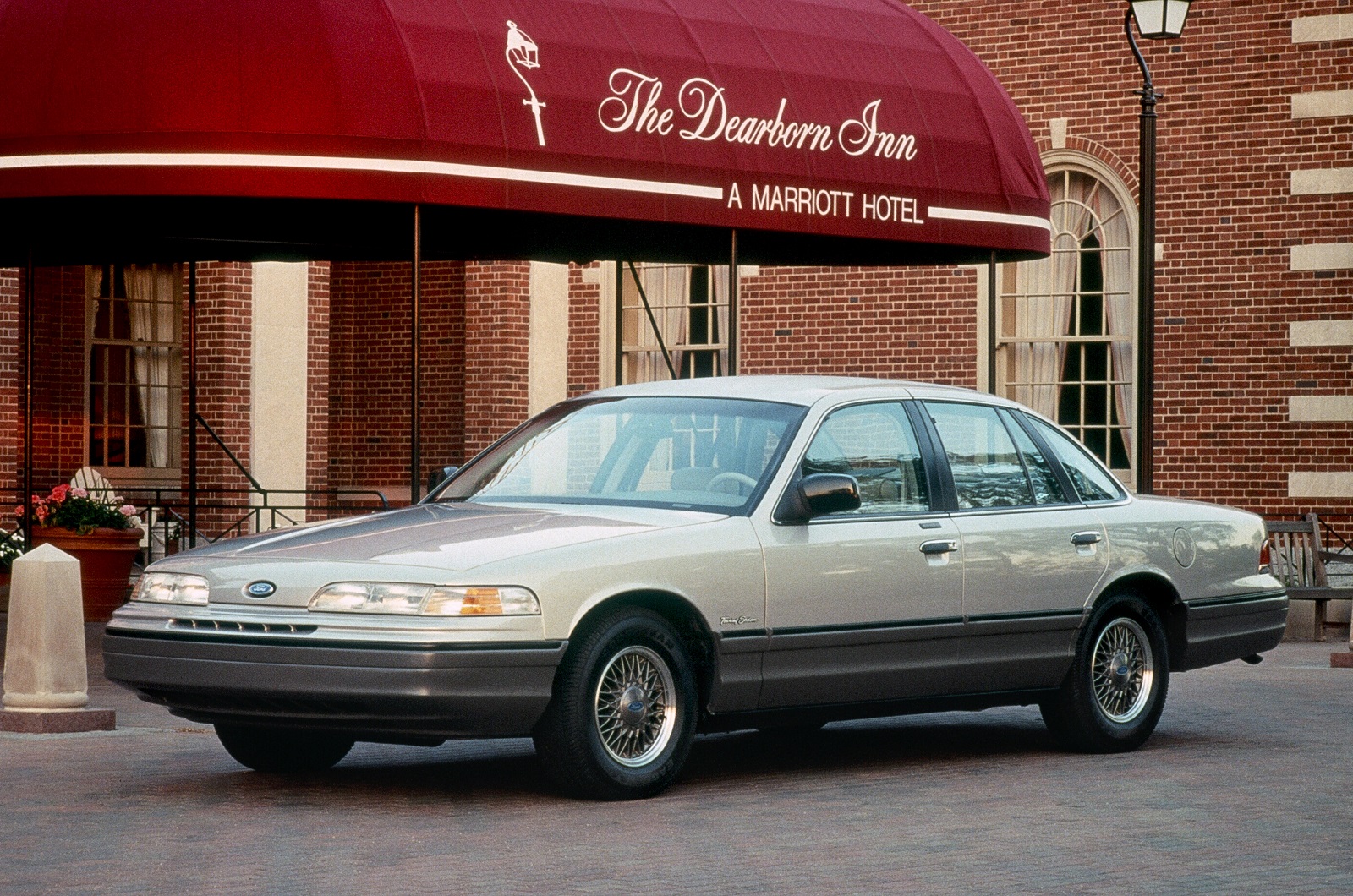
Crown Victoria (1992)
As competitors downsized, Ford continued thinking big. 1992 brought a completely redesigned Crown Victoria with more modern-looking lines and an evolution of its predecessor’s tried-and-true Panther body-on-frame construction. Colloquially called the Crown Vic, it was never envisioned as a volume model but it was a hugely important part of the Ford range because it performed taxi and law enforcement duties across America. It also spawned the Mercury Grand Marquis and the Lincoln Town Car, which were aimed at a different set of buyers.
Selling a V8-powered behemoth with a truck-like ladder frame in the 1990s sounded like a recipe for disaster but Ford beat the odds. Crown Victoria sales stayed above the 100,000 mark for most of the decade and it was popular enough to warrant the launch of a comprehensively updated model for 1998. It hogged an 85% share of the police vehicle market in America and in Canada in 1999, so keeping it around — and even investing money into improvements — made financial sense.
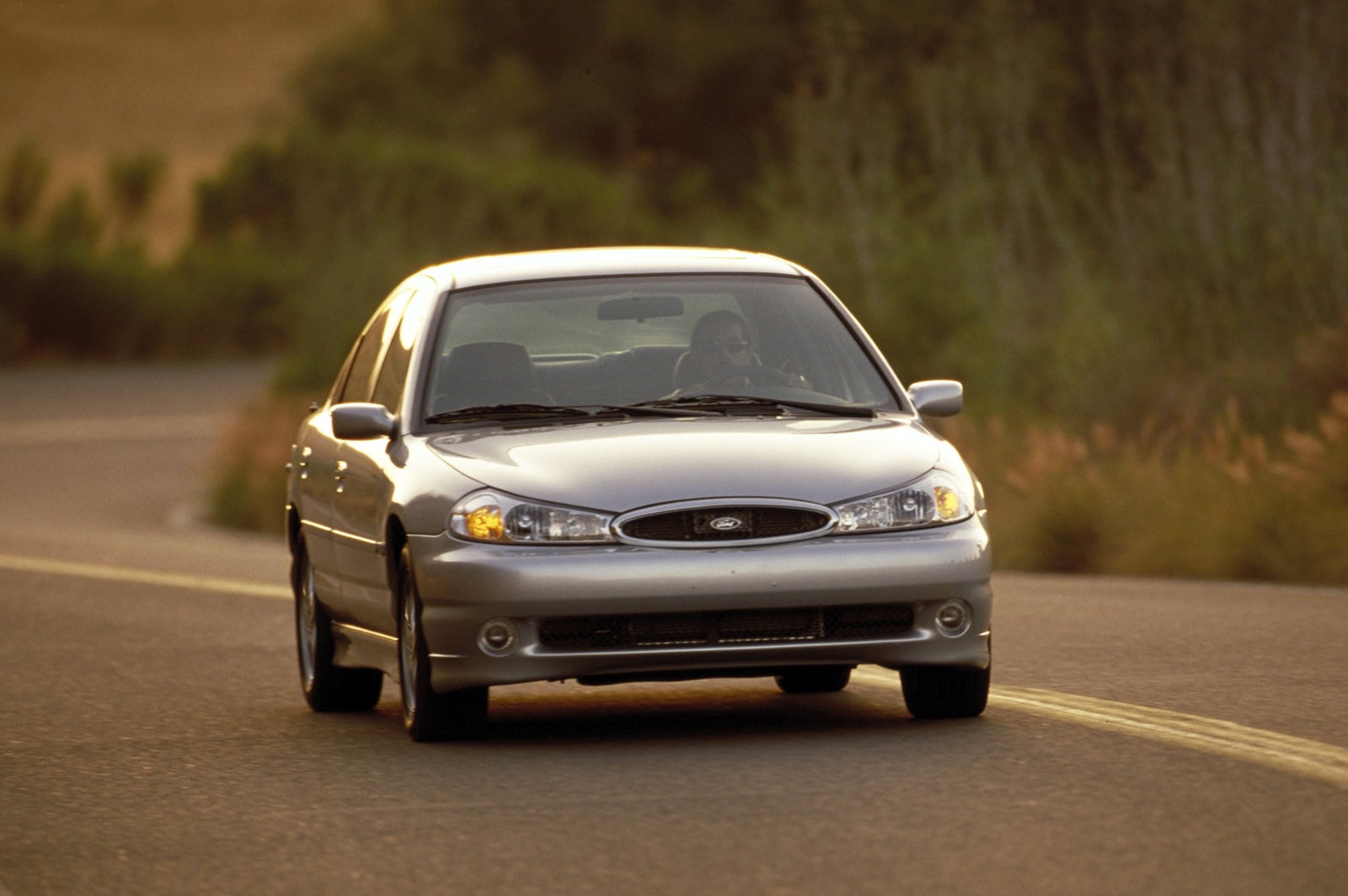
Contour SVT (1998)
The limited-edition Contour SVT complemented the Taurus SHO in Ford’s sport saloon range for 1998. It was based on the Contour, which was related to the first-generation Mondeo, and developed by the Special Vehicle Team that also created the SVT Lightning and the SVT Cobra, among other models.
It was not merely a souped-up family car. It received a comprehensive list of performance upgrades including a 2.5-litre V6 with 192bhp on tap, a stainless-steel exhaust system and a five-speed manual transmission. Subtle visual modifications set it apart from the humbler variants of the Contour. Production of the Contour SVT was initially limited to 5000 units annually.
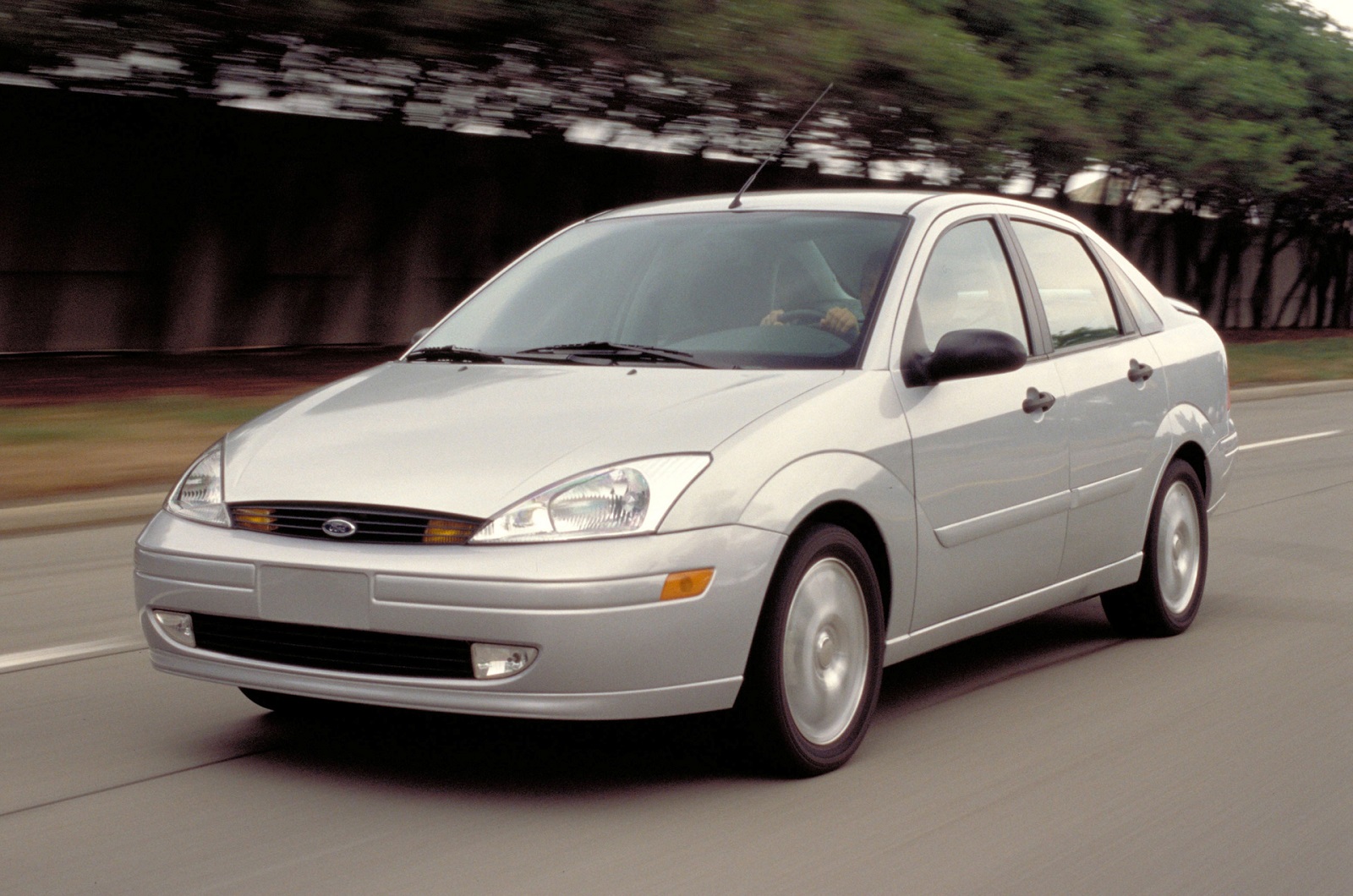
Focus (first generation, 1999)
Cheap, cheerful, and wholly unremarkable, the third-generation Escort released for 1997 fizzled out during the early 2000s after a rather short production run. It was replaced by one of the most revolutionary hatchbacks ever to wear the Blue Oval emblem: the first Focus. Executives again swung towards the global car side of the pendulum and chose to sell the same basic car in dozens of markets.
Launched for the 2000 model year in America, the Focus was characterised by crisp styling and just-right dimensions. Above all, it offered an important attribute that its predecessor lacked: desirability. While millions bought an Escort out of necessity, many motorists ended up in a Focus because they liked it.
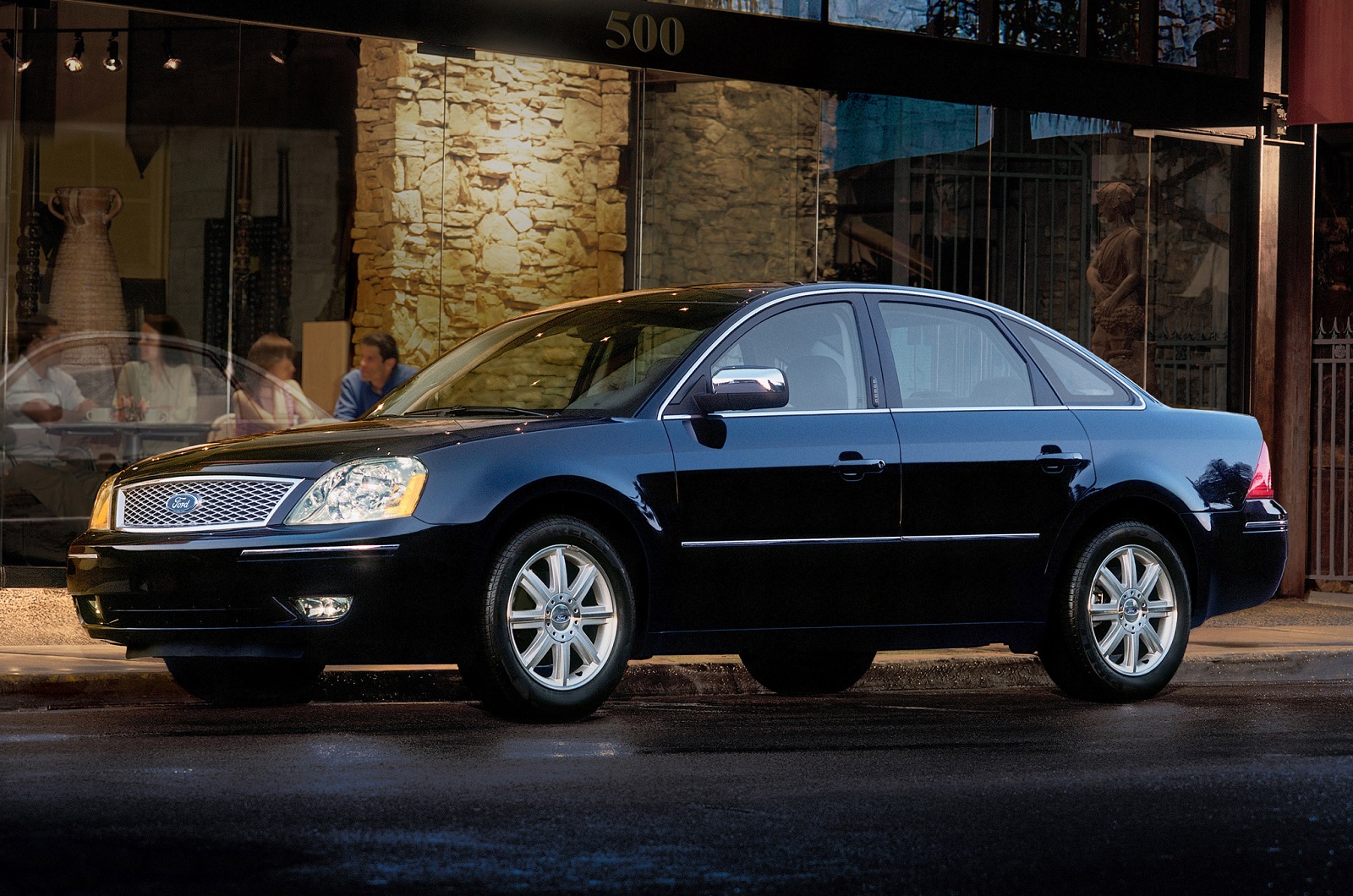
Five Hundred (2005)
Ford positioned the Five Hundred at the top of its saloon range as an alternative to the Crown Victoria. While it was large and softly suspended, it landed with front-wheel-drive, unibody construction and a V6 engine. It was given a lukewarm reception by buyers and 367,402 units were sold from 2004 to 2007.
Alan Mulally, the former Boeing executive who became Ford’s boss in 2006, axed the Five Hundred. He insisted that the updated model released for 2008 resurrect the Taurus name that buyers were far more familiar with. Mercury’s version of the car, the Montego, was rebadged Sable for the same reason.
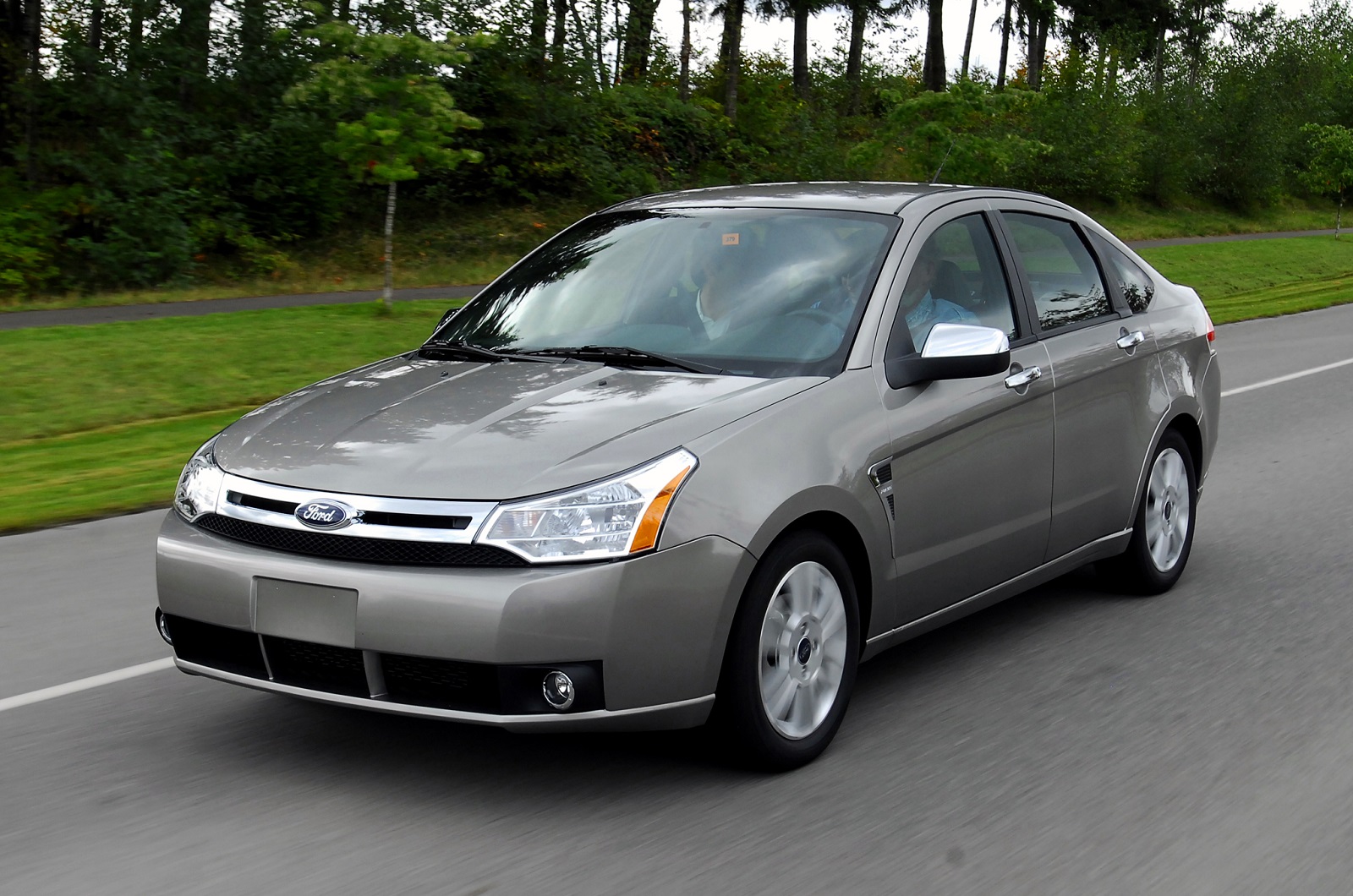
Focus (second generation, 2008)
While buyers in Europe received a new second-generation Focus in 2004, motorists in America settled for an improved version of the original model with redesigned sheet metal, a new-look interior plus several mechanical and chassis upgrades. Ford predictably dropped the estate and hatchback body styles that buyers had little interest in, leaving only the saloon and the coupe to carry the name forward.
Annual sales initially shot up because the Focus arrived during the Great Recession, when demand for cheap, fuel-efficient and robust cars skyrocketed. In hindsight, however, it was a lukewarm carry-over model launched largely to power Ford through a difficult time. Production ended in late 2010.
Sometimes referred to as the second-generation model, the updated Focus is the only variant of the nameplate whose annual sales didn’t manage to break the 200,000-unit mark. Economic turmoil and Ford’s perilous financial situation certainly played a role in its lacklustre career. Regardless, the firm learned a valuable lesson and brought the global-market Focus back to America for 2012.
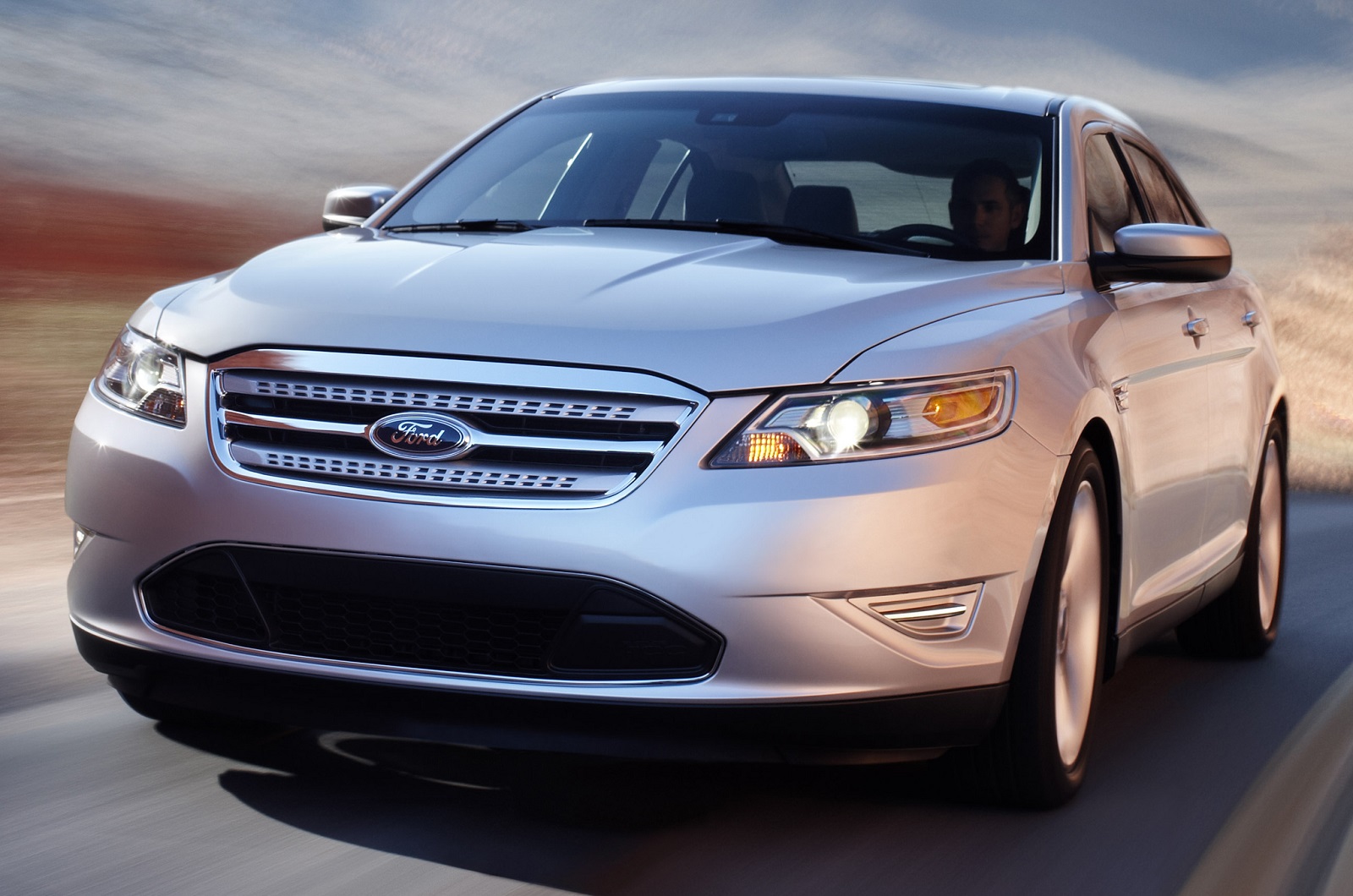
Taurus (2010)
Ford gave the Taurus nameplate one last shot at success when the sixth- and final-generation model arrived for the 2010 model year. Like its predecessor, which started life as the Five Hundred, it was much bigger than the 1980s model and it consequently competed in a different segment. Ford envisioned it as a replacement for the Crown Victoria, especially in the all-important fleet market.
While the Police Interceptor Sedan attempted to fill in for the Crown Victoria, the born-again SHO model (pictured) tried luring enthusiasts back into the fold with a 360bhp V6 and standard all-wheel-drive. It was too little, too late; the Taurus landed in a collapsing segment. Even law enforcement officers shunned it in favour of the rear-wheel-drive Dodge Charger Pursuit and Ford’s own Explorer, which was called Police Interceptor Utility in marketing-speak.
Sales peaked at 69,603 units in 2013 and dropped to 9,924 in 2019 — a rounding error in the 1980s. Ford built the last Taurus for the American market in March 2019. Production continues in China, though the Chinese-spec Taurus shares only a name with the version sold in America in the 2010s.
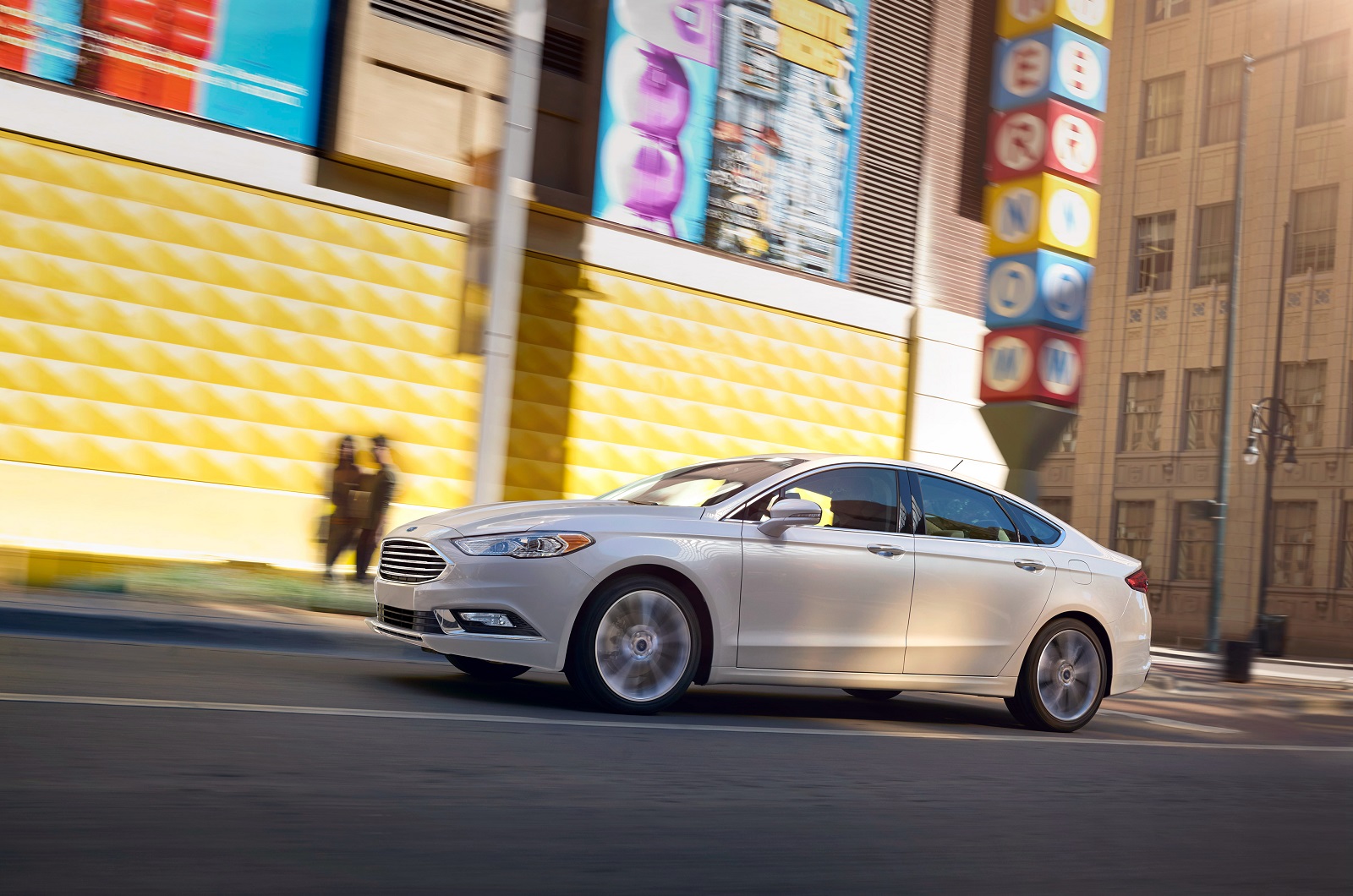
Fusion (second generation, 2013)
Launched for the 2013 model year, the second-generation Fusion was the last new saloon Ford designed for the American market. Closely related to the fourth-generation Mondeo, it was offered in a diverse selection of variants ranging from basic rental car-spec models to upmarket trims that leaned towards the luxury side of the scale. One of the highlights was the 320bhp Sport released for 2017.
Sales reached 306,860 units in 2014, a figure that made it the 10th best-selling nameplate in the United States. It nonetheless finished far behind the Toyota Camry (428,606 sales) and the Honda Accord (388,374 units). Popular disinterest in the Fusion’s segment grew during the 2010s and deliveries crumbled accordingly. Fusion sales totalled 166,045 and 110,665 units, respectively, in 2019 and 2020.
Ford stopped taking orders for the Fusion in February 2020 and production ended in July of that year in Hermosillo, Mexico. The assembly line didn’t remain idle for long: it now builds the Bronco Sport.

The end of the Falcon (2016)
Ford’s Australian division triggered a domino effect in 2013 when it announced plans to stop building cars locally. It made its last saloon, a blue Falcon XR6, in October 2016 and closed the Broadmeadows assembly line shortly after. All told, it built about 3.5 million units of the Falcon in 56 years.
Toyota and General Motors shuttered their Australian manufacturing operations shortly after. While the move cost thousands of jobs, Ford argued it was inevitable because demand for locally-built rear-wheel-drive saloons was free-falling. In 2003, it sold nearly 75,000 units of the Falcon in Australia. In the early 2010s, annual sales dropped under the 20,000-unit threshold with no signs of going back up.
Even without the Falcon, Ford remains near the top of the Australian sales chart. It sold 39,540 units of the Ranger in 2020, a figure that makes the truck the second-best-selling vehicle in Australia.

The end of the Mondeo (2022)
Citing “changing customer preferences,” Ford confirmed in early 2021 that it will stop making the Mondeo for the European market in March 2022. It told Autocar that sales fell to 2400 units in 2020, which represents little more than a rounding error.

The end?
The final Mondeo rolled off the line in Valencia on Monday 4th April 2022. Ford production engineer Federico Ertl posted a picture on LinkedIn (above), with a message in Spanish, translated as: “Yesterday we said farewell to the Ford Mondeo. The truth is that it is very sad to think that these have been the last two vehicles produced and that I will no longer see them at the plant. And if I feel sorry for myself, I can't even imagine what it’s like for those who saw it born!”
Around 5 million Mondeos were sold in Europe in total since launch. The Spanish factory continues to build cars like the Kuga SUV. But this isn’t quite the end of the Ford saloon story…
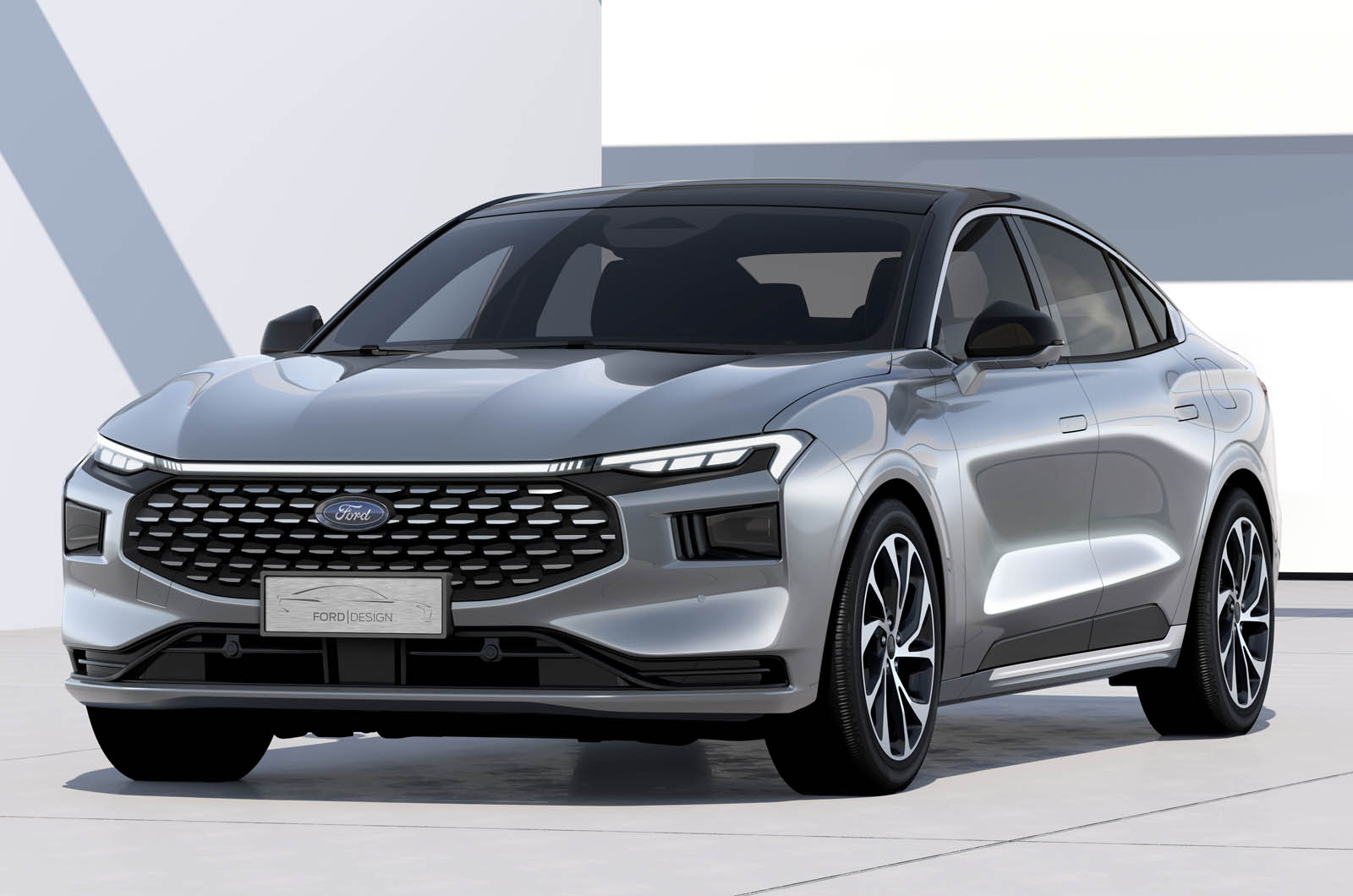
The Mondeo Mk5
There is actually a fifth generation Mondeo, but it’s only going to be built in China and sold into that and certain other Asian markets – and won’t come to the UK or indeed the US. An end of an era, certainly, but not quite the end for this storied nameplate. The Ford saloon lives on, sort of - but you'll have to work increasingly hard to buy a new one.
More for You
This town may only have enough drinking water for the next month
Israel fears ICC preparing ARREST WARRANT for Benjamin Netanyahu
Grammy-winning American Idol star Mandisa dies aged 47
Rory McIlroy makes immediate change after Masters disappointment on PGA Tour return
4 wedding red flags that hint a marriage won’t last
‘Pulp Fiction' Cast Reunites and Reminisces on Film's 30th Anniversary: "It Changed Cinema"
For rent: the country piles that were panic-bought during Covid
Public sector job cuts: Affected staff criticise leaders' handling of announcements
US will build its first new nuclear warhead in 40 years
20 hit songs we don’t want to hear anymore
Amateur sensation turns down PGA Tour in move putting LIV Golf on red alert
Pulp Fiction cast honour Bruce Willis as they reunite to mark film's 30th anniversary in LA
X to fight Australian watchdog over stabbing content
Crew of migrant rescue boat acquitted in Italy after seven-year ordeal
Costly late penalty miss leaves Phoenix on back foot in race for A-League Premier's Plate
Taylor Swift name-drops Patti Smith and Dylan Thomas on new song. Here’s why
The worst things you can do before going for a run
ONE BILLION people set to vote in six-week Indian election
OPINION - Yes it's okay to ban children from pubs: trust me, I grew up in one
Magic Castle Trial: ‘America's Got Talent' Magician Charged With Revealing Secrets